- Norwegian Cruise Line

Amateur Radios on NCL?
By LTCSZ , May 9, 2016 in Norwegian Cruise Line
Recommended Posts

I was thinking of taking my amateur radio handheld radio on my cruise to the US Virgin Islands and making some contacts with local amateurs...Has anyone had experience using amateur radios on NCL? I would not use it while the ship is underway, only while in USVI...It is not capable of transmitting on any ship radio frequencies...Any experiences would be appreciated!
Link to comment
Share on other sites.
Why not do all your DX from home instead of bring the portable gears ? Typical port stop @USVI is 8 hours at most ;) for getting the green lights.
Written permission is expected and should be obtained from the cruise line and ship's captain, etc. ahead of sailing - here's a blog from a fellow Ham http://www.ka3nam.com/ka3nam-vp9-mm/obtaining-permission-from-the-cruise-line
Best practices/guidelines from AARL - http://www.arrl.org/maritime-mobile-operation-in-international-waters
I was only planning on taking a two meter hand-held to make a few contacts while in the US Virgin Islands...Not while on the ship...Just planned to get off of the ship and try to contact a few of the local repeaters...There are several in St Croix (NP2VI/147.11+/100 PL)
K - understood your original intent. But, cruislines, including NCL - as I understood, should they find (... they might not) your 2 meter Yaesu or Icom, etc. in your checked or hand luggage (without the shorty antenna & charger) - ship security might "store" it safely for you, as a precaution against out-of-band ops) until disembarkation. Then, you will have zero access to it while ashore - write to them ahead as a matter of courtesy, that's my point for what it's worth.
Good luck & enjoy your cruise :cool:
Good point...I didn't realize that they would confiscate a radio if found...Don't want to get into a discussion with the ship security! I will try emailing NCL for their policy...Thanks again...
Steve KA1OWC

All-ready2cruise
My DH takes a hand held with him all the time (he works for a radio manufacturer). He only uses it to listen to marine traffic. He uses it on the Islands and that's fine (as long as you're licensed).
Also, something which might be of more interest, Steve, there is a group who cruise together almost every year and have an agreement with CCL whereby they are permitted to use their radios while on the ship. The HAM radio enthusiasts must be licensed and agree to stay within the guidelines set by the cruise line but, other than that, it's all good.
If you want more info on this, let me know.
I would really appreciate a link to the CCL ham cruise info! That sounds like real fun! Thanks a lot...
I would really appreciate a link to the CCL ham cruise info! That sounds like real fun! Thanks a lot... Steve
Yes, it sounds like a lot of fun. We had to cancel our reservation on it but you might like it.
Can you send me an email Steve? ( conniecruzes at outlook dot com ) I can't actually post the info here but would be happy to give you Debbie's email address.
email sent! Thanks
Duplicate post...Sorry
Sent to NCL:
Hi: I have a question regarding my upcoming cruise on the Escape on 4 June. I would like to bring along a small, hand held Amateur Radio for use only in the US Virgin Islands on our stop there. I assure you that it would not be used while on the ship, that it is not capable of transmitting on ship/marine channels, and that I am licensed for it's use in US Territories...I have heard that some cruise lines will confiscate such a radio and hold it during the cruise. Can you advise me as to NCL's policy in this regard? I appreciate the cruise line's concerns regarding security, but as a licensed Amateur Radio Operator (KA1OWC) I give you my word that I would follow any protocols NCL may have. Thank you very much for your attention to my inquiry.
Good point...I didn't realize that they would confiscate a radio if found...Don't want to get into a discussion with the ship security! I will try emailing NCL for their policy...Thanks again... Steve KA1OWC

Yes, it might get confiscated if found without prior permission, as despite your protestations, it could be used in contravention of the ship's radio telegraphy license.
- 4 months later...

Good information for first time users who are #hamradio folks to know before showing up at the dock.
Thanks for sharing.
Lloyd, KC5FM

HAL is ham friendly, qcwa had a group cruise a few years ago.
- 1 year later...
PROHIBITED ITEMS LIST
The safety and security of our guests and crew is our number one priority. The following items are prohibited on-board vessels. These items will be confiscated and not transported aboard. When an item is determined to be illegal the appropriate authorities will be informed.
- 1. All illegal narcotics/drugs. (Including Marijuana prescribed for medical purposes and other items used as drug paraphernalia. This includes Hookah Pipes).
- 2. All firearms including replicas, imitations, non-firing weapons, starting pistols and their components
- 3. Air, BB or pellet pistols or rifles
- 4. Any other projectile-weapon or item that resembles or can be mistaken as a firearm (e.g., paint ball guns)
- 5. All ammunition or replica ammunition for listed line items 2, 3 & 4
- 6. All explosives, component parts (i.e. detonators) including imitation explosives and devices
- 7. Fireworks, flares, and pyrotechnics
- 8. Martial Arts Weapons (i.e. throwing stars, flails)
- 9. Knives with a blade longer than 4 inches/10.16 cm
- 10. Open razors
- 11. Swords, Skean Dhus, or Kirpans
- 12. Spears or spear guns
- 13. Crossbows, crossbow bolts, and long bow arrows
- 14. Blunt weapons including knuckle dusters, brass knuckles, clubs, telescopic batons, batons, flails or nunchaku
- 15. Items containing incapacitating substances (e.g. gas guns, tear gas sprays, mace, phosphorus, acid and other dangerous chemicals that could be used to maim or disable
- 16. Restraining Devices (i.e. handcuffs, leg, and head restraining straps)
- 17. Flammable substances and hazardous chemicals. (e.g., petrol, methylated spirits, paint thinners, lighter fuel, etc.)
- 18. Any other item made, adapted or intended for use as an offensive weapon
- 19. Stun devices (i.e. Tazers and Stun Guns)
- 20. Large batteries
- 21. Items brought on board the vessel and not supplied by the Company containing any kind of heating element, such as but not limited to: immersion heaters, heating blankets, clothing irons, water heaters, coffee machines with heating/hot plates, etc.
- 22. Any remotely controlled or autonomously flying devices, toys or drones
- 23. Self-balancing hover boards, air wheels, scooters, or Segway’s
- 24. Compressed gas tanks, bottles, cylinders including dive tanks, propane tanks and large aerosol cans
- 25. Emergency Position Indicating Radio Beacons (EPIRB), ham radios, satellite phones, transformers, lasers and laser pointers
- 26. Any form of radio/ telephone signal jamming equipment
- 27. Samsung Note 7
- 28. Candles

wow diving deep into the depths for a posting 1 1/2 years old...
I have brought my HT with me on every cruise. I’ve never had any problems. Not even a second look. Both a Yaesu ft-60R, and a Baofeng UV5. I’d be unhappy if anything happened to the Yaesu, it has been with me longer then my first wife. If the Baofeng gets damaged or destroyed, I’m out $30.
Ed, KC2JCD.
Sent from my iPhone using Forums
I have brought my HT with me on every cruise. I’ve never had any problems. Not even a second look. Both a Yaesu ft-60R, and a Baofeng UV5. I’d be unhappy if anything happened to the Yaesu, it has been with me longer then my first wife. If the Baofeng gets damaged or destroyed, I’m out $30. 73 Ed, KC2JCD. Sent from my iPhone using Forums
Ed, on checked bags or carryon?
Have you cleared these radios with the Captain? As these are 5 w UHF/VHF transceivers, even if you only wish to use them on the amateur bands, they need to be listed on the vessel's Radiotelephony Certificate, or written permission from the Captain. I believe that even the amateur bands (since these are in the HF band, I think), and at 5 watts needs to be cleared with the Captain for use onboard.
I have no problem not transmitting on board.
Just would like to assured it wouldn't be confiscated if dissembled, battery out, in a carry on.
So, given NCL's list, don't plan on bringing it.

BirdTravels
I have no problem not transmitting on board. Just would like to assured it wouldn't be confiscated if dissembled, battery out, in a carry on. So, given NCL's list, don't plan on bringing it.
Confiscated. Taken to the naughty room. And thrown with the other illegal contraband to be collected upon disembarkation.
Checked bags. I listen only on the ship, as you would need permission from the captain to operate while on board. I’ve never had a problem, they have never called me to ask about it, or confiscated it. If security were to ever ask, I would just say you use it to keep in touch with friends who were also on the cruise.

don't-use-real-name
All of the above noted - - -
AND THEN OPERATING IN A FOREIGN COUNTRY
A whole nother set of laws rules regulations mandates etc. etc. etc.
While not the same type of device I used to take my hand held multi-band scanner
with me was confiscated by Carnival* returned at the end of the cruise.
No longer going thru that Spanish Inquisition** just to bring my toy along.
* after that never tested the waters with any other cruise line.
** visits to the Naughty Room to retrieve your belongings are so intimidating -
wearing your Cruisers Badge of Shame for conduct unbecoming to cruising !
- 1 month later...

The Carnival family used to permit ham radios to operate aboard. You got a polite
letter in you stateroom at embarkation asking you to bring your stuff to the Purser
for inspection and approval. If you were on Princess (Bermudian flagged) you also
had to show a operating permit from Hamilton, usually emailed from RAB.bm.
That all changed last year about the same time Sun Princess darkened ship each
night and practiced evacuating outside cabins as they tip-toed past the Horn of
Africa. Ham radios are now "prohibited items", and even phoning the person who
had arranged permissions 6 months before it was "That was then, this is now,
I'm embarrassed and very sorry, but no way, no how, period".
Connect the dots. And take guidance from the resultant picture.
I have been taking my Yaesu VX-7 handhelds for years on my NCL cruises with no problems. The crew can't tell the difference between HF and the Walmart walkie talkies, which were prevalent years back. I used 2 meter simplex on land, and found that 440 worked great in getting through the metal bulkheads. 5 watts was more than sufficient.
Please sign in to comment
You will be able to leave a comment after signing in
- Welcome to Cruise Critic
- New Cruisers
- Cruise Lines “A – O”
- Cruise Lines “P – Z”
- River Cruising
- Cruise Critic News & Features
- Digital Photography & Cruise Technology
- Special Interest Cruising
- Cruise Discussion Topics
- UK Cruising
- Australia & New Zealand Cruisers
- Canadian Cruisers
- North American Homeports
- Ports of Call
- Cruise Conversations
Announcements
- New to Cruise Critic? Join our Community!
Write Your Own Amazing Review !

Click this gorgeous photo by member SUPERstar777 to share your review!
Features & News

LauraS · Started Friday at 01:11 PM
LauraS · Started Wednesday at 08:11 PM
LauraS · Started Tuesday at 07:43 PM
LauraS · Started April 30
LauraS · Started April 26
.jpg.00c527646bf20dd6c0ff5cba146c8700.jpg)
- Existing user? Sign in OR Create an Account
- Find Your Roll Call
- Meet & Mingle
- Community Help Center
- All Activity
- Member Photo Albums
- Meet & Mingle Photos
- Favorite Cruise Memories
- Cruise Food Photos
- Cruise Ship Photos
- Ports of Call Photos
- Towel Animal Photos
- Amazing, Funny & Totally Awesome Cruise Photos
- Write a Review
- Live Cruise Reports
- Member Cruise Reviews
- Create New...

Using Two-Way Radios to Keep in Touch on Cruise Ships
Keeping in touch with friends or family on a cruise is easy if you're going to be purchasing an onboard WiFi package , but often guests look to handheld radios or "walkie-talkies" for a cheaper way to coordinate happenings on ever-larger ships with countless distracting events. This can certainly be an effective option for some, but you'll want to keep reading to learn about features, options, reasonable expectations, and a few "gotchas" before relying on two-way radios on your cruise. Warning, I'm an amateur radio operator, used to work in radio communications, and a bit of a nerd - but I'll try to keep things simple.
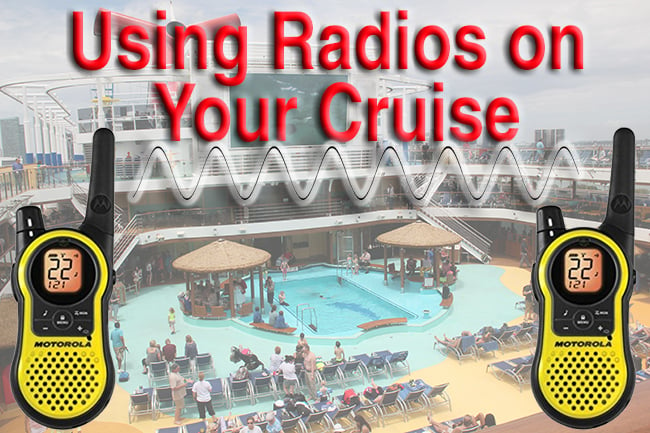
Radio Types
Generally speaking what you're going to buy for unlicensed use, as a consumer, are going to be Family Radio Service (FRS) radios in the US, or Personal Mobile Radios (PMR446) in the EU. The two are essentially the same product in concept, but they work on different frequencies, and cannot communicate with each other. Further, they're each on frequencies licensed for use only in the US or EU, respectively. In either case, the radios have similar restrictions, though for the purpose of the rest of this article, we'll be talking about the specifications for FRS radios.
- Power output. FRS radios are restricted to .5 watts or 2 watts, depending on the model and channel.
- Antennas. You can't attach larger or external antennas, as they're fixed.
- They operate mostly around 462MHz (this is the frequency range - think about the number of your favorite radio station).
With the above restrictions in mind, you're not going to find a special model or brand which has materially greater range than another. If you see a radio with different specifications (such as 5 watt output), that is a GMRS or other radio, which requires licensing.
Performance and Range
FRS radios on land may cover, in optimal conditions, a couple of miles - and that's pushing it. If you search online for these radios you'll see them advertising ranges of five, ten, even 35 miles - this is an absolute lie. It won't happen. Sometimes marketers work this into the ad in a way that suggests a significant range, but they really mean that you'll be able to pick up weather radio (if so equipped) from a great distance. Any given radio in this category will have the same range, provided you're comparing two models with the same output (again, some models output 2 watts on specific frequencies). On a ship, range will be greatly diminished.
The range of any radio is dependent on several primary factors:
- Antenna design
- Antenna height
- Power output
- Obstructions
As we already covered, the antennas and power output on these radios is restricted, and when you're using the radios to communicate with friends on a ship, you don't have much control over height. Obstructions are an important point, because on land radio range is often dictated by line of sight, but on a ship you will have obstructions. Steel hulls, watertight doors, flooring, miles of cabling, thousands of people, swimming pools, slot machines, furniture, plumbing, etc - these are all obstructions. Further, the electrical systems on ships can cause interference, which is a sort of electronic obstruction.
For the sake of understanding and ensuring realistic expectations, I'll point out that even radios used by police and fire departments don't have drastically greater range than these radios on their own. Police and fire departments, as well as some businesses use repeaters, and networks of repeaters, to greatly expand range in the same way in which cell sites work. Your cellphone can't get a signal to your friend on the other side fo the country, but infrastructure can, and FRS radios do not rely on any infrastructure.
Will FRS Radios Cover an Entire Ship?
Maybe. You'll find plenty of folks who have successfully used these radios on ships, and plenty of others who have had issues. Cruise ships today are larger than ever and have more electronics and metal structures to compete with. It's likely you'll have far better success using these radios on say, the 84k GT Disney Magic , than the 228k GT Harmony of the Seas. There are other variables too, like how many other people onboard are using said radios, which brings up another concern which is clouded by marketing: privacy.
Can Other People on the Ship Listen to My Conversation?
In short, absolutely. These radios are not intended to be secure or private in any way. You may see some radios that advertise a feature called "privacy codes" or something similar, but make no mistake, this feature helps reduce how much you hear other people not how much they hear your conversations. These codes are actually sub-audible tones which tell radios with that same tone to listen.

This means without using privacy codes, if you and I are both on channel one and anyone uses their radio on that channel, we'll hear them, regardless of their use of privacy codes. If you and I start using privacy code 024 (for example) on channel one, our radio's speakers will only turn on when someone is transmitting on that channel with that privacy code. This feature is certainly useful for reducing the amount of chatter you hear, but it doesn't make anything private. Further, if two people are speaking at the same time on the same frequency, and one is using your privacy code and the other isn't, you may still hear both of them simultaneously.
Again, just because this feature doesn't do anything at all to ensure privacy, don't dismiss it - it's a great feature to have, though generally comes at a cost. There are still some inexpensive options though, such as this set of two radios from Midland , which include the privacy code feature.
Is Using Radios on Cruise Ships Legal?
The laws around using various types of radio equipment while at sea can be somewhat complicated, but for the purposes of FRS (or PMR446) radios it's not something I'd personally worry about. Using these radios while in port though is another concern. The frequencies that the devices used are allocated for this type of casual unlicensed use only within the US (or EU for PMR446). Those frequencies may be used for other things in other countries. For example, some of the FRS frequencies in various parts of Europe are used for commercial and public safety voice communications. In many cases, you're not likely to hear anything on the channel even if you're interfering with communications, either because the channel you're on is the input channel for a system (not the output), or because the system you're causing interference to is digital (and thus sounds like regular static on a handheld radio).
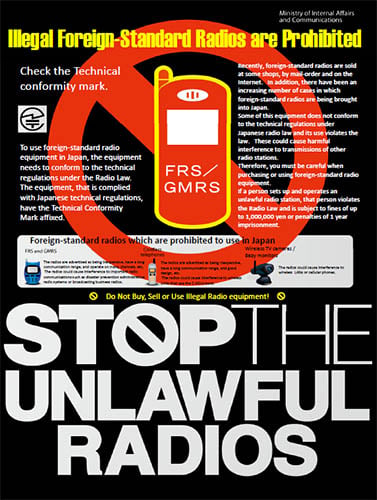
While no major issue is likely, it is a less than ideal situation, for sure. In theory, a country could fine or prosecute someone for using unapproved equipment or equipment operating on a frequency they're not licensed for - but I'm quite confident you wouldn't actually see this play out from these radios, just making the point that spectrum is something carefully managed on a per-country basis.
Consider Guest Comfort
If you choose to use radios to keep in touch, do make sure your family keeps in mind the comfort of other guests. No one wants to be relaxing in a lounge, tanning poolside, or enjoying a meal with a view only to hear "Jimmy meet me at the cabin, I forgot my key!" screeching over a nearby radio. Many of these radios are capable of using headsets/earpieces, similar to wired sets used for cellphones. Some even have features that allow you to keep the volume turned down and have the radio vibrate when someone keys up using the same channel and privacy code. Whether with common sense or features, just keep in mind that messages important to you may not be quite as welcome to other guests.
Billy's Recommendation
Personally, I feel cellphones are frequently the most convenient way to keep in touch with your cruising party. If you don't want to splurge and pay for WiFi (note, you'll be fine with "social only" packages on lines that offer them), and the ship you're sailing on doesn't have a free messaging app, remember that many of us enjoyed cruises with family long before smartphone were even an option. While I offer caution and want to be sure people have reasonable expectations if opting to use radios on cruise ships, I can certainly appreciate their utility.
If you think this is the right way to go for your traveling party, I would look for radios which are water resistant, come with rechargeable batteries, offer privacy code functionality, and include a vibration alert feature. Motorola is likely to offer some of the highest quality devices, but that of course comes at a bit of a cost premium. I'd also look to avoid radios which are FRS/GMRS radios, only to reduce the chance of accidentally causing interference, but you can of course follow the instructions provided with the radios to not use those power settings, channels, and features.
Below are a few selections that stand out to me and might help you get started in your quest, but Amazon has scores of options from which to choose.
Have questions about staying in touch on your cruise? What's been your experience with two-way radios at sea? Comment below or reach out on Twitter or Facebook !
View the discussion thread.
Cruise Ships and Ports
Scanner frequencies.
Also see these great resources:
- Cruise Ship & Maritime Frequencies
- Cruise Ship Frequencies - radioreference.com Forums

- Search forums
- International Radio Discussion Forums
- Caribbean Radio Discussion Forum
Cruise Ship Frequencies
- Thread starter ecps92
- Start date Apr 23, 2007
- Tags cruise line cruise ship
- Apr 23, 2007
Looking to expand our resources with other Scannists in the various ports of the Islands. Bill
Good afternoon. Here's a terrific frq. list: http://home.earthlink.net/~ecps92/frequencies.htm
Mick said: Good afternoon. Here's a terrific frq. list: http://home.earthlink.net/~ecps92/frequencies.htm Click to expand...
- Sep 3, 2007
Those are good references. I have noticed Carnival sells FRS radios in the gift shop , but NCL frowns upon radio use. It can be interesting to listen to FRS on cruise ships.
Ray_Air said: Those are good references. I have noticed Carnival sells FRS radios in the gift shop , but NCL frowns upon radio use. It can be interesting to listen to FRS on cruise ships. Click to expand...
- Sep 4, 2007
I was just on Disney recently and have scanned Disiney and Carnival. I found the FRS/GRS frequencies full of tourist coms. The ships can be interesting but like scanning a Hotel. But the most fun was on the ship in Nassau the bahamas...on the top deck, heard al sorts of comms in the 900 mhz bands, wireless mics from other ships? in the 180 - 200 mghz band and lots of interesting stuff by searching areas of spectrum....180 - 220 mhz, 800 - 950 mhz as an example. I was up on the top decks and overlooking the city. Now maybe my cheapo alinco Dj X3 was having a intemod or IF... heart attack... from close RF, Nassua was full of antennas.. but I heard lots of cool stuff. Wish I had more than a few hours too listen and take notes... Just a few thoughts...searching can prove intersting....73 Ray
- Sep 10, 2007
I sailed Carnival in 2005 and we brought our own frs radios. They were useless because literally hundreds of other passengers had the same idea. Plus they only punch through one maybe two decks. It was good scanning. When we sailed Princess in 2006 there were also lots of frs rigs in use.
- Sep 11, 2007
Rover said: I was just on Disney recently and have scanned Disiney and Carnival. I found the FRS/GRS frequencies full of tourist coms. The ships can be interesting but like scanning a Hotel. But the most fun was on the ship in Nassau the bahamas...on the top deck, heard al sorts of comms in the 900 mhz bands, wireless mics from other ships? in the 180 - 200 mghz band and lots of interesting stuff by searching areas of spectrum....180 - 220 mhz, 800 - 950 mhz as an example. I was up on the top decks and overlooking the city. Now maybe my cheapo alinco Dj X3 was having a intemod or IF... heart attack... from close RF, Nassua was full of antennas.. but I heard lots of cool stuff. Wish I had more than a few hours too listen and take notes... Just a few thoughts...searching can prove intersting....73 Ray Click to expand...
- Jan 10, 2008
silverbk said: They were useless because literally hundreds of other passengers had the same idea. Plus they only punch through one maybe two decks. Click to expand...
mlindler said: So is it even worth it to bring a UHF radio(FRS/GMRS) on a cruise? Would it be better take radios on another band (MURS? 42mhz??). I was considering going P25 on my upcoming cruise to keep interference down. Click to expand...
- Jan 11, 2008
ecps92 said: IF your looking for No Interference [to you and to your CREW] I would go VHF High MURS. P-25 might cause problems to other [Countries] other than maybe P-25 on amateur. What band were you going to use P-25 on ? Click to expand...
- Mar 11, 2009
Carnival Conquest Does anyone have any frequencies for the Carnival Conquest. Sailing out of Galveston, TX in Jan 2010 Cruise Ship & Maritime Frequencies <-- Has nothing
- Mar 12, 2009
rbarker said: Does anyone have any frequencies for the Carnival Conquest. Sailing out of Galveston, TX in Jan 2010 Cruise Ship & Maritime Frequencies <-- Has nothing Click to expand...
- Mar 26, 2009
- May 13, 2009
I always take a radio, and scan FRS, business, and especially the Marine band. Holland America uses marine channels for port and excursion ops, sometimes very entertaining. Even my wife likes to listen. I've seen other people with scanners and Marine HTs as well. I've also use VHF/UHF ham radio in ports and made a few contacts. Just be sure of your licensing status outside the US.
- Sep 2, 2009
ecps92 said: Looking to expand our resources with other Scannists in the various ports of the Islands. Bill Click to expand...
- Sep 5, 2009
FYI, if you're looking for reliable on ship 2-way communications I highly recommend the Motorola DTR radios. We recently had entire ship interference-free coverage on the Carnival Sensation. These DTR's were the generation 2 models with the longer removable 900MHz whip antennas. Most of Carnival's ships are the same. I have been on the Paradise, Triumph and Sensation and they were all similar. I was really impressed with the DTR. If you want to spend less money on radios you could try the TriSquare eXRS radios. They use somewhat similar technology, but are less rugged, use analog voice, and have very small non-removable antennas so I don't know how coverage would be. In any case, I am willing to bet they would still be better than using FRS.
- Sep 23, 2009
I guess this is an old conversation, but I thought I would share this anyway... The last cruise ship I was on, I brought a set a Motorola Spirit radios. I set them up using a privacy code. They worked great. I was in Casino & wife was in cabin 3 floors away & oposite end of ship & we talked no problem. On the cruise before that I brought the family radios with crappy reception & lost signals once we were 1 floor apart.
Similar threads
- Apr 19, 2024
- Marine Monitoring Forum
- Apr 5, 2024
- Whistler Scanners
- Apr 6, 2024
- Virginia Radio Discussion Forum
- Apr 17, 2024
- IrwinMFletcher
- Apr 9, 2024
- Wisconsin Radio Discussion Forum

Can You Use Walkie-Talkies on a Cruise Ship & Do They Work?
When you’re traveling with family or friends on a cruise, you’ll want to stay in touch, but communicating on a cruise ship can be difficult, and the charges are sometimes excessive.
To avoid the risk of charges, it’s usually best to put your phone on airplane mode and check your partner and family to do the same (we learned this the hard way).
Most cruise lines offer Internet access, but it can be expensive to use Wi-Fi at sea. Of course, when you’re out at sea, there is often no cell phone signal, so you can’t call or text as you normally would on your cell phone.
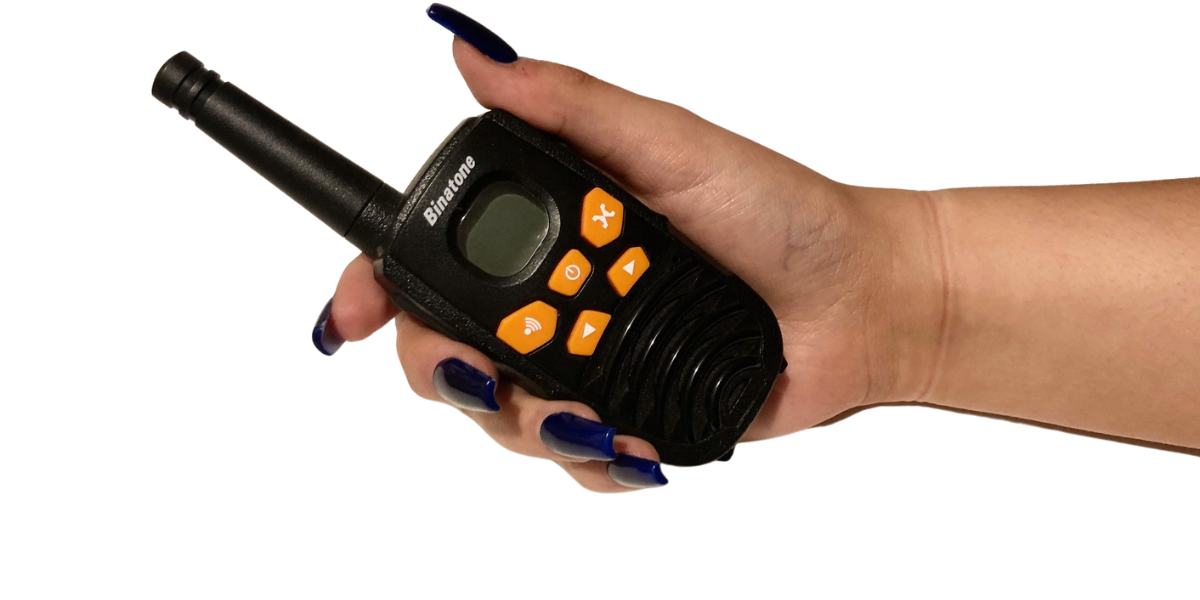
One way to communicate freely while on a cruise ship is to use a walkie-talkie / two-way radio. However, while they are an extra option to keep in touch, especially if you have kids onboard, they have their limitations .
Are Walkie-Talkies Allowed on a Cruise Ship
Most cruise lines allow walkie-talkies or two-way radios on board, but they may have to meet certain specifications that will vary depending on the cruise line.
If you forget your walkie-talkies or see other people using them and think they look like a good idea, some cruise ships offer the chance to rent them on board. This is more likely on a smaller cruise ship than a mega-cruise ship because they are more likely to work better on a smaller vessel.
Restrictions
It’s worth bearing in mind some cruise lines may have restrictions on the type of two-way radio you can use on board. For example, Royal Caribbean explicitly states on its website that only FRS/GMRS two-way radios are allowed and must have a ship mode setting.
Some cruise lines may also have limits on:
- Maximum watts of power
- Prohibit external mounting antenna
Can You Use Walkie-Talkies on a Cruise Ship

Most cruise lines allow passengers to use Walkie-Talkies on board the cruise ship. However, a few considerations influence how well they work and whether they are the best option for staying in touch with your group.
The size of the cruise ship will impact how well the Walkie-Talkies work. Generally, the smaller the cruise ship, the better the Walkie-Talkies will work. This is because fewer obstacles, such as walls and other passengers, can block the signal.
It’s also always worth considering other passengers when you use them so as not to annoy or disturb the peaceful surroundings they may be enjoying.
Do Walkie-Talkies Work on a Cruise Ship
Walkie-Talkies are primarily designed for use in the open air and should work well if both users are outside, ideally in line of sight. The more obstacles between you, the more interference you can expect.
Walkie-talkies work by transmitting radio signals, and with the majority of cruise ship structures being made of steel, they can block or interfere with radio signals, so most models will not work at all well if you are inside the ship.
That said , there are types of walkie-talkies that use Ultra High Frequency (UHF) signals that can penetrate walls, floors, and ceilings , so if you’re in a cabin on a cruise ship, you might be able to use one of these to communicate with someone in another room or on another deck.
Some walkie-talkies use the Global Positioning System (GPS), so you can keep track of where everyone is on the ship. However, these are usually not allowed on cruise ships.
Using Walkie-Talkies On A Cruise Ship
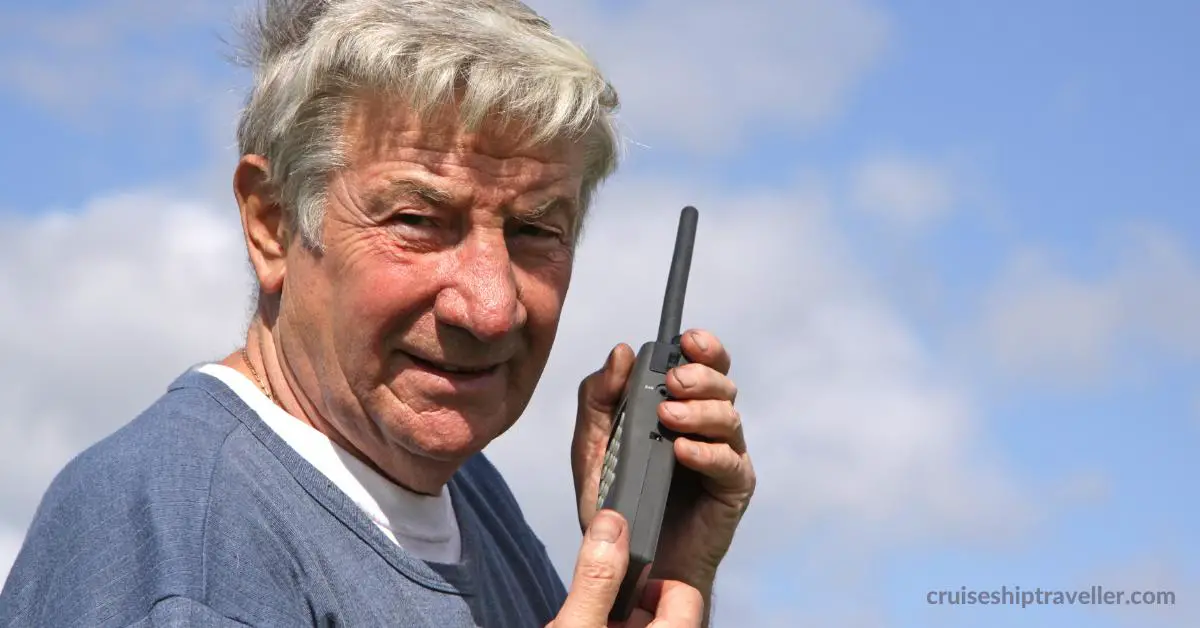
How and when you can use a walkie-talkie on a cruise ship will depend on which type you have and where you are on the ship.
Inside Cabin
If you want any chance of using a walkie-talkie from inside a cruise cabin, essentially a steel metal container, you will need to make sure you have a UHF two-way radio model.
These models can transmit signals through steel walls to someone in another room and through ceilings giving you the best chance of making contact with someone on another deck.
All other kinds of walkie-talkies will have difficulty penetrating the ship’s metal walls, so they will only be of use in outside areas.
Outside Cabin
If you are outside your cabin, you have a much better chance of your walkie-talkie working, and even more so if you are on the outside decks .
Outside on the promenade deck, lounging on the sun deck, or the pool deck, they should work well, assuming you are comfortably within range and both outside. The fewer obstacles between you both less interference you will incur.
Internally, even outside your cabin, there are still many structures that can block or significantly weaken the signals, so don’t expect the device-stated ranges to be anything like that in reality.
One of the best places to communicate on a walkie-talkie is when you are both on the ship’s top deck.
There are usually fewer structures to block the signals, and you are more likely to be in the range of each other, especially if the other person is outside, even on a lower deck. However, the lower they are, the more likely you will experience some static.
Onshore Excursions
Walkie-talkies can be ideal for use onshore during excursions in foreign countries as you can easily keep track of everyone in your group within a range of 2 to 5 miles depending on the model, without having to incur phone charges.
On land, the walkie-talkies work much better and more in line with the ranges set, but this depends on your area and surrounding structures.
Plus, whether inside or outside, buildings will also make a difference.
If you are visiting a port outside of the US, check the local regulations for the use of two-way radios, even if it is an FRS radio in case you unwittingly enter into a foreign country’s frequencies and possibly public safety or commercial channels.
Can Other People Hear Your Conversations?
It’s possible other passengers onboard the ship can tune into the same channel, just as you might come across other channels.
If this happens, you can simply change the frequency, which is easier if you have a model which allows multiple frequencies.
Some two-way radios have a privacy code feature that offers users many private channels. Although this doesn’t mean other people can’t hear you, it just means you don’t hear them because it filters out walkie-talkies that aren’t on the same code.
It’s also worth highlighting that being on a walkie-talkie in a public space on a cruise ship unless you are wearing an earpiece, other passengers will be able to hear both sides of the conversation, and some may find the noise aspect annoying and make a complaint.
How to Increase the Range of Walkie-Talkies on a Cruise
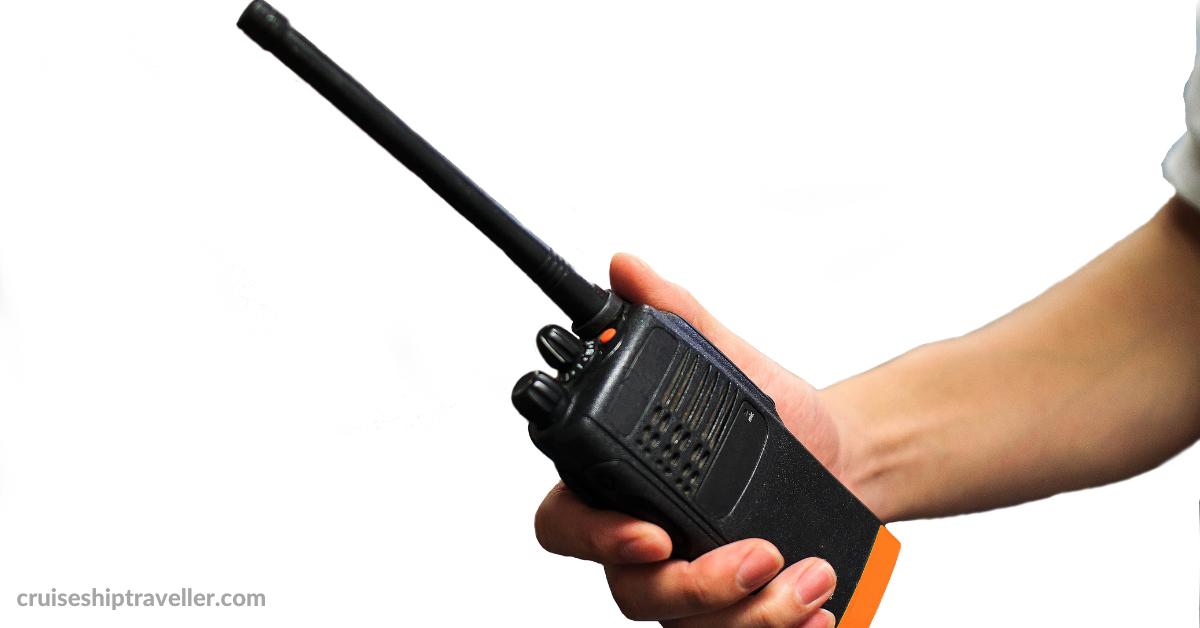
Just because a range is stated on a walkie-talkie doesn’t mean it will work to its full potential on a cruise ship. Various factors can limit the range, from obstructions to the weather.
However, you can do a few things to increase the range, improve the signal, and reduce the static of your walkie-talkie while on your cruise ship or an excursion.
Assuming you have purchased a model with a good range, you can try the following tips.
The first is to try and find areas on the ship with fewer obstructions between yourself and the person you’re trying to reach. If you are both outside, that would be ideal.
Make sure the antennas are extended as much as possible, both on your walkie-talkie and the one you are trying to communicate with.
Ensure your 2-way radio is fully charged or has high-strength batteries. As the batteries weaken, this will affect the strength of the signal they are transmitting.
Should You Bring a Walkie-Talkie on a Cruise (pros and cons)
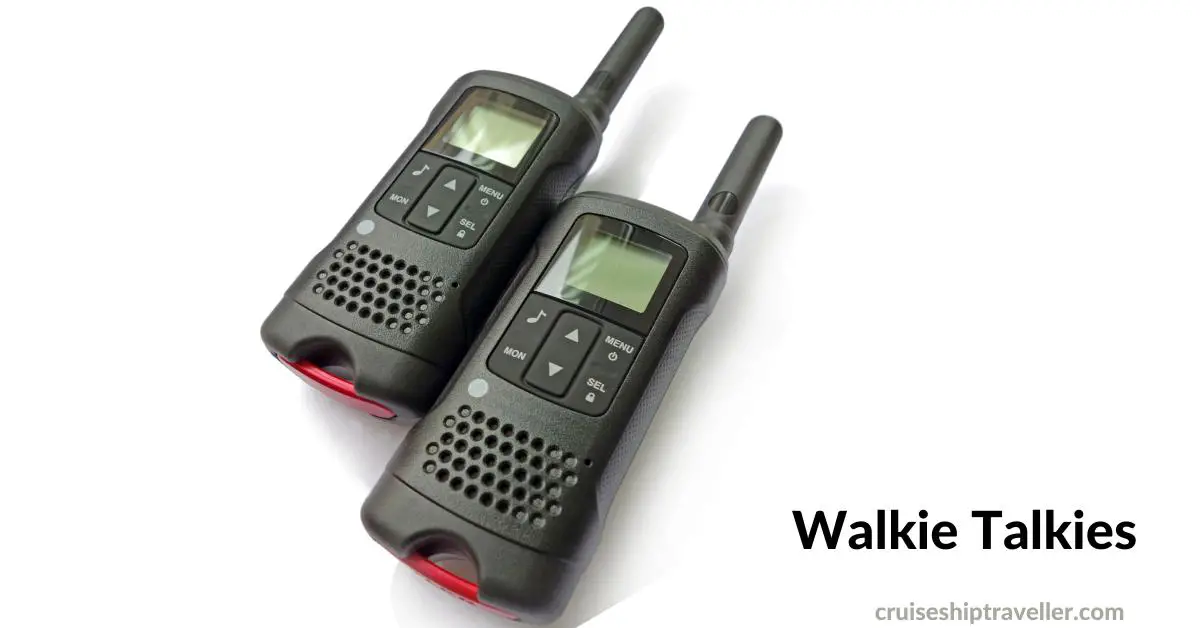
Now that you know how well walkie-talkies work on a cruise ship, the next question is should you bring one?
- Cheaper than using a cell phone or cruise line internet access
- Helps keep you off your phone while on vacation
We say cheap rather than free because you’ll have to buy the walkie-talkies first, and some models may need batteries.
Some people enjoy a vacation with no devices, and no temptation to check work emails or see bad news.
- The distorted sound might be annoying to other passengers unless you have earpieces
- Won’t work from your cabin (unless UHF)
- Range not extend the entire length of mega-ship
- Others may overhear your conversations
- May lose them if you put them down somewhere
Types of Walkie Talkie
There are 3 main types of walkie-talkie that you may consider using, but some are more suitable than others.
FRS – Family Radio Service radios are relatively cheap and easy to use, so they will be suitable for all family members. They operate on FM waves with 14 channels and up to 2 watts in power. No license for use is required.
FRS walkie-talkies should work if you are on the outside decks and have models with a good range, albeit with some static the further you are apart. However, they simply won’t work inside the ship due to all the obstructions.
GMRS – General Mobile Radio Service radios are more potent than FRS radios with a maximum of 60 watts of power. They can transmit over greater distances, up to 5 miles. However, using them in the United States requires a license, and you must be over 18 to apply.
Also, they may not even be allowed on some cruise lines, so best to check in advance.
UHF Radios – Ultra-High Frequency radios are powerful 2 ways radios that can transmit signals which can penetrate the steel structures of a cruise ship.
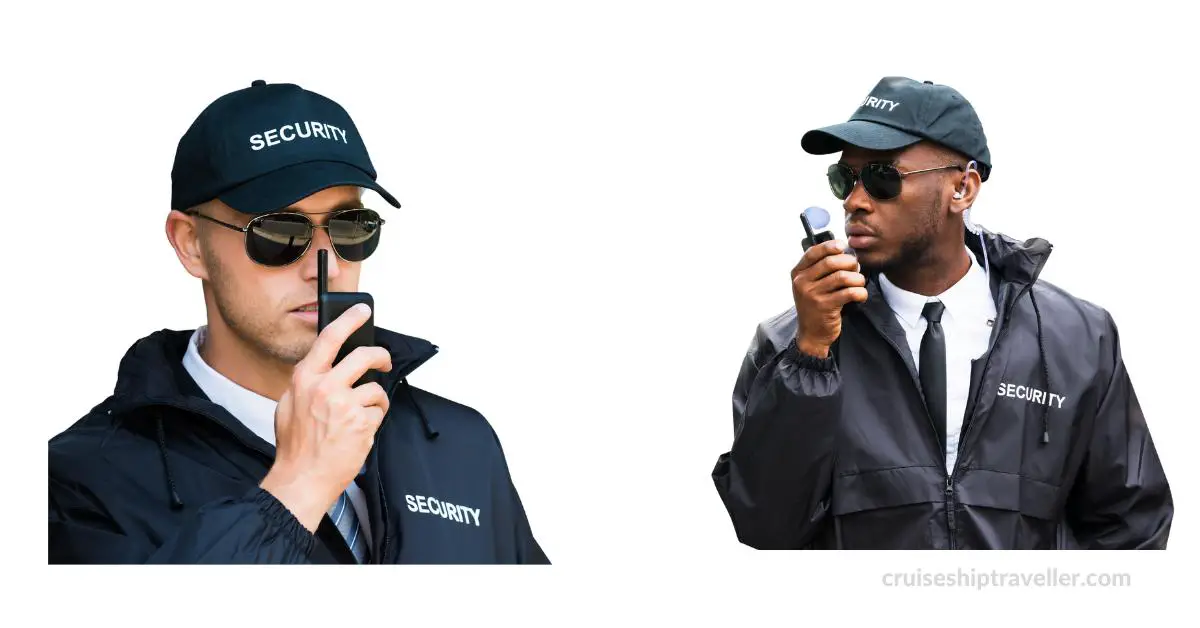
Best Walkie-Talkie for Cruise Ship
The best walkie-talkie for a cruise ship is one that uses UHF frequencies, has multiple channels, and has a privacy code feature.
The UHF frequencies will enable you to communicate through the steel structures of the ship and in private if you have a model with multiple channels with privacy code options.
For large ships and onshore excursions, make sure you look for models with as extensive a range as possible.
A good battery life with a talk time of around 15 hours can also be advantageous. We prefer models with a rechargeable battery base rather than take separate batteries.
The final consideration would be to choose a model or retailer that offers a 2-year warranty.
Best walkie-talkie checklist:
- UHF frequencies to communicate through cabin walls
- Multiple channels and privacy codes for private communication
- Earpieces for communicating discreetly
- Long range for large ships and onshore excursions
- Good battery life or battery-saving features
- Rechargeable battery
- Warranty for peace of mind
Walkie-talkies can be brought in pairs, with some models available in larger packs if you want to use them in a large group.
Free Alternatives to Walkie Talkies
Walkie-talkies aren’t the only option for communicating for free on a cruise ship.
Over the years, we have used several others, some of which are useful to have or know about as a backup, even if you do have your two-way radios with you.
Free Cabin to Cabin Phone Calls
If you and the person you want to call are likely to be in their cabin, you can just call them for free using the in-room phones.
Cabin phones can be used to call other cabins on the same ship for free.
It’s also worth noting that there are usually free phones around other parts of the ship you can use to call cabins.
Whiteboard or Sticky notes
Whiteboards or sticky notes are suitable for communicating as people come and go from within the cabin. You can keep each other updated on your latest whereabouts or next meet-up location and time.
Frequently Asked Questions
Do walkie-talkies work from inside cruise ship cabins.
Only the more powerful and expensive UHF two-way radios will work from inside a cabin. The steel walls and ceilings will block all other walkie-talkie signals.
Do Cruise Ship Staff Use Two-Way Radios?
On your cruise vacation, you may spot staff using walkie-talkies. These are usually high-end models with extended antenna which may not be allowed for use by the public as they can become a safety hazard (pokes to eyes) to other passengers.
All considering walkie-talkies can be a viable way of communicating on a cruise ship for free. While they have limitations, they can be ideal for communication if both users are on the outside decks or offshore excursions.
If you want the opportunity to communicate directly from cabin to cabin, you will have to consider a UHF two-way radio, but it’s worth always being aware that you are not causing an annoyance to surrounding passengers.
So while walkie-talkies can be effective to some degree, I would also consider backup options for communicating with friends and family while onboard.
If you have any experience or tips for using or choosing a walkie-talkie on a cruise, please share them in the comments we would love to hear them.
Related Posts

Can You Bring a Vape on a Cruise? (2024)

Can You Bring Curling Irons On a Cruise Ship?
Leave a comment cancel reply.
Your email address will not be published. Required fields are marked *
Save my name, email, and website in this browser for the next time I comment.

14 Best Walkie-Talkies For Cruise Ships
This article may contain affiliate links .
This article will comprehensively review the best walkie talkies for cruise ships, considering their features, performance, durability, and user-friendliness.
- 1 Are walkie-talkies allowed on cruise ships?
- 2.1 Do Walkie-Talkies Function Inside Cruise Ship Cabins?
- 2.2 Do Walkie-Talkies Function Outside of Cabins on a Cruise Ship?
- 2.3 Do Walkie-Talkies Function on a Cruise Ship’s Top Deck?
- 3.1 Topsung M880 Two-Way Radios
- 3.2 Ansoko Long-Range Walkie Talkies
- 3.3 Retevis H-777 Two-Way Radios
- 3.4 Retevis RT22 walkie-talkies
- 3.5 Retevis RT49P Waterproof Walkie Talkies
- 3.6 SANZUCO Long Range Walkie Talkies
- 3.7 MOICO walkie-talkie Set
- 3.8 Midland GMRS Two-Way Radio
- 3.9 Pxton Walkie-Talkies
- 3.10 Topsung 2 Way Radios Walkie Talkies
- 3.11 Motorola T200
- 3.12 Baofeng BF-888S
- 3.13 Motorola T100 Talkabout Radio
- 3.14 Cobra RX680
- 4.1 Can walkie-talkies interfere with ship communications?
- 4.2 How effective is the range of walkie-talkies on a cruise ship?
- 4.3 What are the legal implications of using walkie-talkies on international waters?
- 4.4 How can I increase the range of my walkie-talkie on a cruise ship?
- 4.5 Can walkie-talkies work without a signal or network?
- 4.6 How do walkie-talkies compare to mobile phones for communication on a cruise ship?
- 4.7 Can walkie-talkies pick up signals from the ship’s communication system?
- 4.8 Can other passengers listen in on my walkie-talkie conversations?
- 4.9 How to charge walkie-talkies on a cruise ship?
- 4.10 What is the average battery life of walkie-talkies on a cruise ship?
- 4.11 How do walkie-talkies affect other electronic devices on a cruise ship?
- 4.12 What features should I look for in a walkie-talkie for a cruise ship?
- 5 Conclusion
When embarking on a cruise ship adventure, the importance of seamless and efficient communication cannot be overstated.
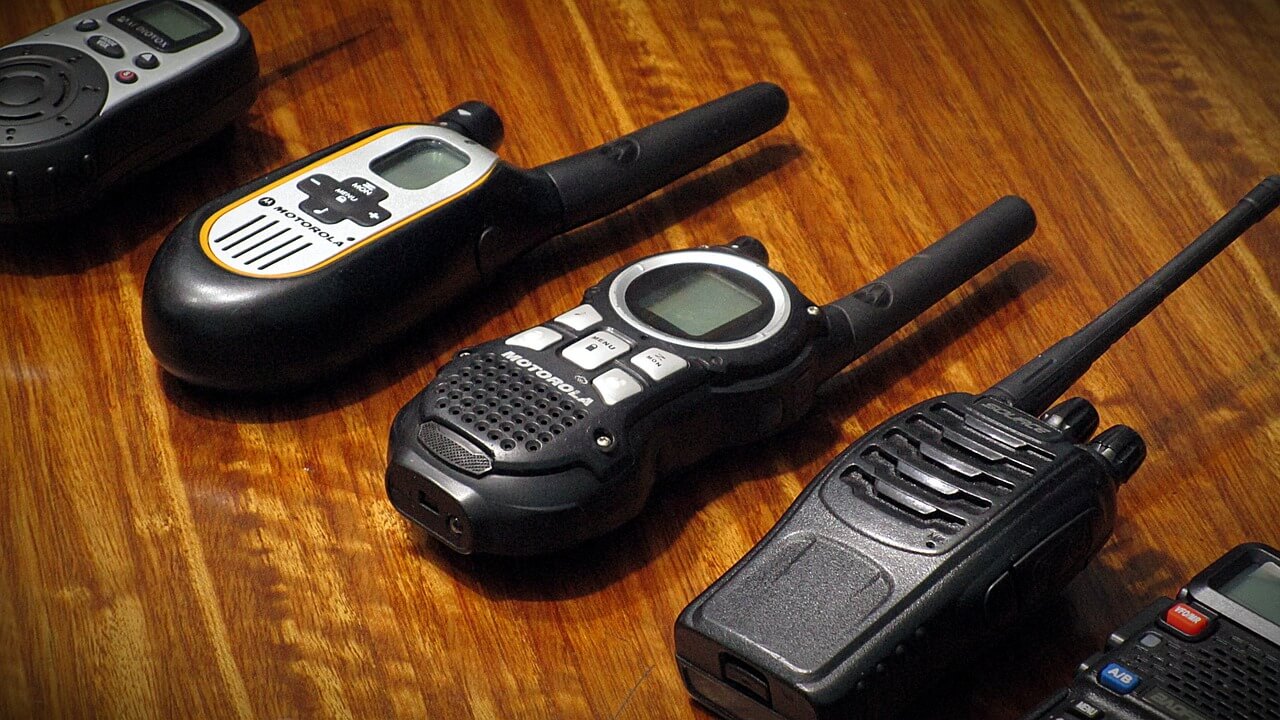
Whether you’re coordinating group activities or just want to ensure the safety of your family and friends, a reliable walkie talkie can make a significant difference.
This table provides a quick way to compare the different products based on key features, pros, and cons. It serves as a useful reference for anyone looking to find the best walkie-talkie for use on cruise ships.
Are walkie-talkies allowed on cruise ships?
Walkie-talkies are generally allowed on most cruise ships, including major cruise lines such as Carnival, Royal Caribbean, Disney Cruise Line, and Princess. Royal Caribbean even sells walkie-talkies in the onboard shops on some of their ships. However, there are certain limitations and requirements:
- The type of walkie-talkie: FRS (Family Radio Service) walkie-talkies, which allow private, two-way, short-distance voice and data communications, are typically allowed. They do not require a license for operation.
- Cruise lines may prohibit walkie-talkies that can broadcast beyond the ship, and they might not be allowed when docking in certain countries.
- NCL (Norwegian Cruise Line) specifically prohibits walkie-talkies as of July 2023.
- Walkie-talkies should not interfere with the cruise ship’s signals, such as distress calls.
- GMRS (General Mobile Radio Service) walkie-talkies, which provide more power and range, can be brought onboard if the user has a necessary license. However, using them in port could potentially break local laws if they interfere with security and safety frequencies.
So, it is generally advisable to check with your specific cruise line regarding their policy on walkie-talkies before you sail.
Can you bring a fan on a cruise ship?
Can you bring a vaporizer on a cruise ship?
Do Walkie-Talkies Work on a Cruise Ship?
Yes! Both FRS (Family Radio Service) and GMRS (General Mobile Radio Service) walkie-talkies can be used and work on a cruise ship.
FRS walkie-talkies use a lower frequency wavelength, do not require a license, and can range from cheap toy store options to good quality ones that operate over a few miles. However, they may not work as well within metal structures like cruise ship cabins and are better used in open spaces or public areas on the ship.
GMRS walkie-talkies operate on a higher frequency from 462 MHz to 467 MHz. They are more powerful and can access all of the channels of the FRS, plus a range of exclusive channels. However, using GMRS walkie-talkies requires a license in the US and their use is limited in various parts of the world. Additionally, unauthorized use of the exclusive channels can lead to legal trouble, as they are often used by countries for emergency distress discussions.
Different frequency bands are used by these radios, including VHF (Very High Frequency) and UHF (Ultra High Frequency). VHF walkie-talkies are effective at longer ranges and in open spaces, while UHF walkie-talkies, although having a lower range, can penetrate solid surfaces better and are more suitable for indoor uses.
Therefore, the best type of walkie-talkie for a cruise ship could be a GMRS walkie-talkie due to its power and range. However, due to licensing requirements and potential for misuse, a more common and convenient option is a UHF FRS walkie-talkie. These may not work perfectly inside a metal cruise ship cabin, but stepping into the corridor or a public area can improve their effectiveness.
The FRS and GMRS share channels 1-7 and 15-22, and it’s preferable to use channels approved for general usage by the Federal Communications Commission (FCC), such as channels 8-14 on the FRS, when using walkie-talkies on a cruise ship.
Do Walkie-Talkies Function Inside Cruise Ship Cabins?
Clear communication can be achieved when using a walkie-talkie inside the cabin, provided the other person is just outside in the hallway.
However, if you’re attempting to converse with a friend from inside your cabin while they’re on an upper deck, you might experience communication issues. This could be due to obstructions like walls, ceilings, or metallic components which can hinder the signal.
Cruise ship cabins essentially act as metal enclosures that can greatly reduce signal reception. When coupled with the ship’s steel decks — and taking into consideration all other potential obstacles such as walls, ceilings, and furniture — the effectiveness of the signal is notably diminished.
Do Walkie-Talkies Function Outside of Cabins on a Cruise Ship?
Conversing via a walkie-talkie inside the cabin may not be successful as the signal will likely not reach the other person. However, once you step outside the cabin, there’s no issue with communication.
The device should function well even if you find yourselves at completely different ends of the ship. So, if one of you is enjoying a swim in the pool at one end while the other is sunbathing at the other, you’ll still be able to connect via the walkie-talkie without any concern.
Even when you’re at the top of the deck and the other person is two decks below (as long as they’re not inside a cabin), communication remains possible. However, if the other party is closer to the bottom of the ship, you might encounter some static due to potential signal obstruction from the decks.
As long as both users are outside of their cabins and within the device’s range, the walkie-talkie will operate effectively. The performance of walkie-talkies is significantly reduced when a user is inside a cabin, but they function quite well when both users are outside, moving around the ship.
Simply put, communicating with a walkie-talkie is straightforward when outside the cabin, even if the parties are located at opposite ends of the ship, possibly 800 feet apart.
Ultimately, a walkie-talkie works effectively as long as both users are outside their cabins and within the signal range of the device.
Do Walkie-Talkies Function on a Cruise Ship’s Top Deck?
The upper deck serves as an optimal location for walkie-talkie use on a cruise ship. Communication can occur seamlessly between parties on the upper deck, regardless of their distance apart.
Being one of the finest spots to use a walkie-talkie and binoculars , the cruise ship’s top deck facilitates uninterrupted conversations, irrespective of the space between users. This is due to fewer obstructions and a clear line of sight on the upper deck, ensuring the handsets operate effectively.
Topsung M880 Two-Way Radios
Topsung M880 Two-Way Radios rank highly among the most preferred walkie talkies for cruise ship adventures. They come with an impressive range of features designed to improve communication and ease of use. The Topsung M880’s standout feature is its ultra-long-range capabilities, which ensure clear communication even over vast cruise ship distances.
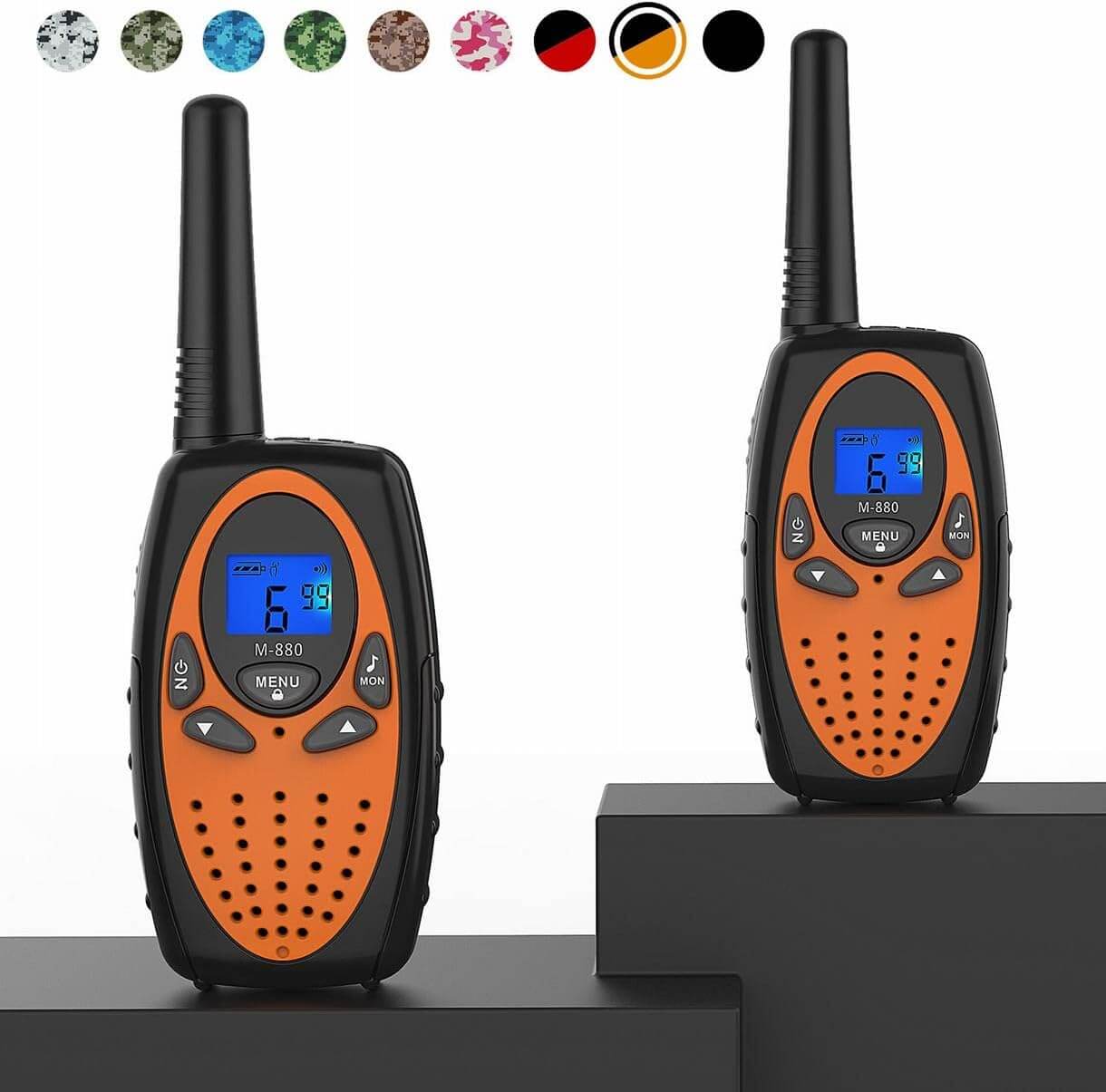
The radios are also remarkably user-friendly, with easy-to-understand buttons and a large LCD screen that makes navigation a breeze. They are compact and lightweight, making them comfortable to carry around without feeling bulky. Additionally, they have a hands-free function that allows for voice-activated transmission, freeing up your hands for other tasks.
The Topsung M880 radios are also durable, with a sturdy construction that can withstand drops and impacts. Their power-saving feature and long battery life further enhance their reliability, ensuring they won’t run out of power in the middle of important conversations. Moreover, the radios come with a built-in flashlight that can come in handy during emergencies or night-time activities.
Despite their robust features, these radios are quite affordable. They offer excellent value for money, given their durability, reliability, and the rich feature set they offer. The M880’s user-friendly interface, coupled with its long-range capabilities and power efficiency, make it an ideal pick for cruise ship adventures.
One potential drawback of the Topsung M880, however, is its limited channels. With only 22 channels available, users may sometimes struggle to find a clear channel, especially in high-traffic environments like cruise ships. Despite this, the Topsung M880 remains a top pick, thanks to its range, clarity, and user-friendliness.
- Long-range communication
- User-friendly interface
- Durable construction
- Limited channels
- Not fully waterproof
Ansoko Long-Range Walkie Talkies
The Ansoko Long-Range Walkie Talkies are designed for users who require a blend of high performance, durability, and versatility. One of the most remarkable features of these radios is their long-range capabilities, which can extend up to 3 miles in open areas, ensuring clear and reliable communication over large distances.
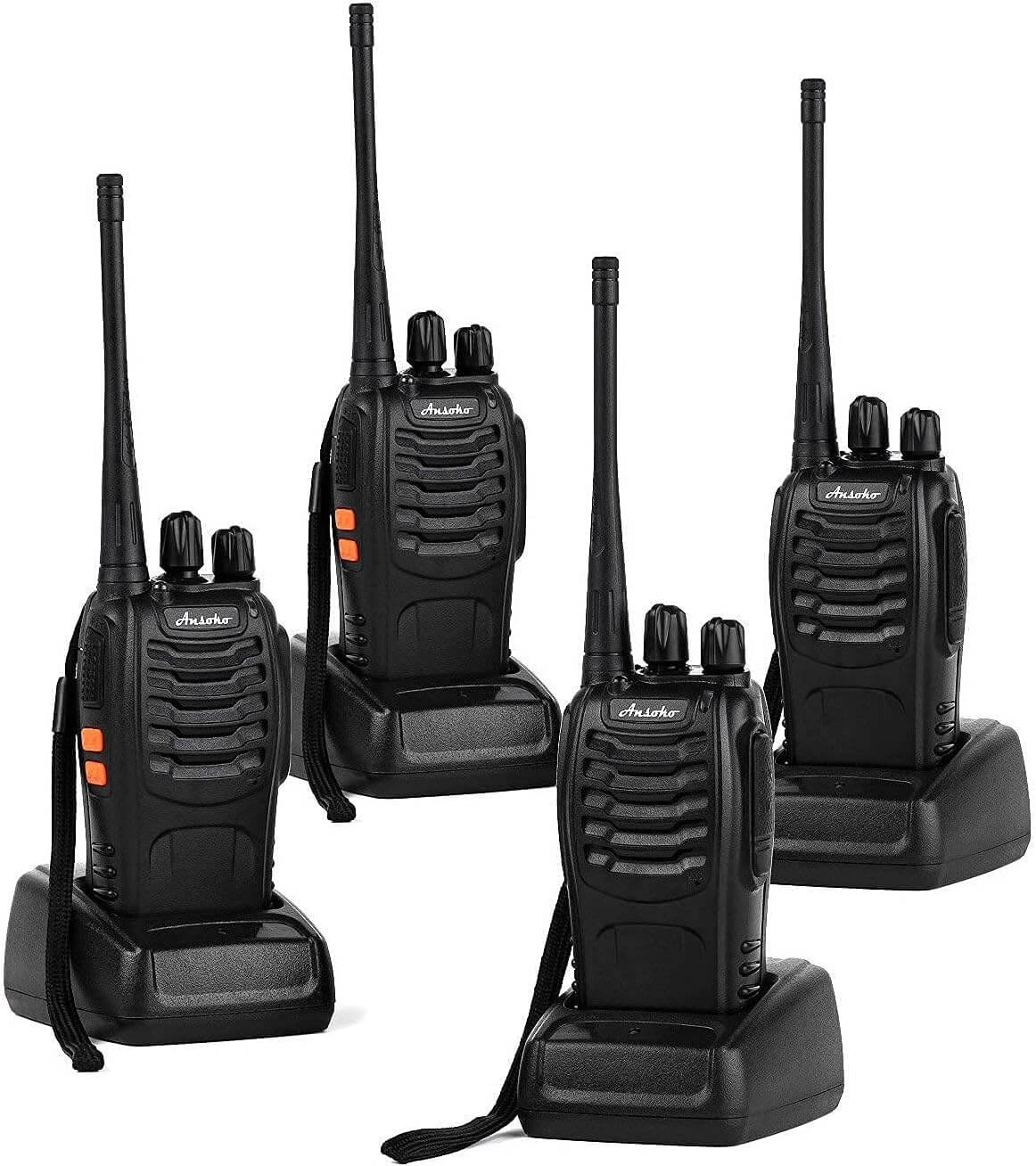
Ansoko walkie talkies are built to last, featuring a robust construction that can endure harsh handling and conditions. They come equipped with a rechargeable lithium-ion battery that delivers long-lasting performance, ensuring you won’t run out of power during your cruise ship adventures.
The walkie talkies boast 16 pre-programmed channels, which users can easily switch between using the channel knob. They also have a built-in LED flashlight, which can be incredibly useful in low-light situations. Their voice prompt feature facilitates hands-free operation, allowing you to engage in other activities while staying connected.
With their clear sound quality and noise reduction technology, the Ansoko Long-Range Walkie Talkies guarantee crystal clear communication. The package also includes earpieces for private conversations. However, they lack a screen, which might make operation slightly more challenging for some users.
The radios also feature a power-saving function, extending their battery life during periods of inactivity. This, coupled with their quick charging capability, ensures your walkie talkies are always ready to use.
Despite the numerous features, these radios are affordably priced, offering great value for the price. They provide reliable, high-quality communication, which is crucial when cruising.
- High range capabilities
- Robust construction
- Power-saving feature
- Requires frequent charging
Retevis H-777 Two-Way Radios
Retevis H-777 Two-Way Radios are yet another viable choice for reliable communication during cruise ship adventures. The radios offer a clear, loud sound that ensures crisp communication, even over long distances. The radios come with a programmable frequency range, giving users the flexibility to set channels that suit their needs.
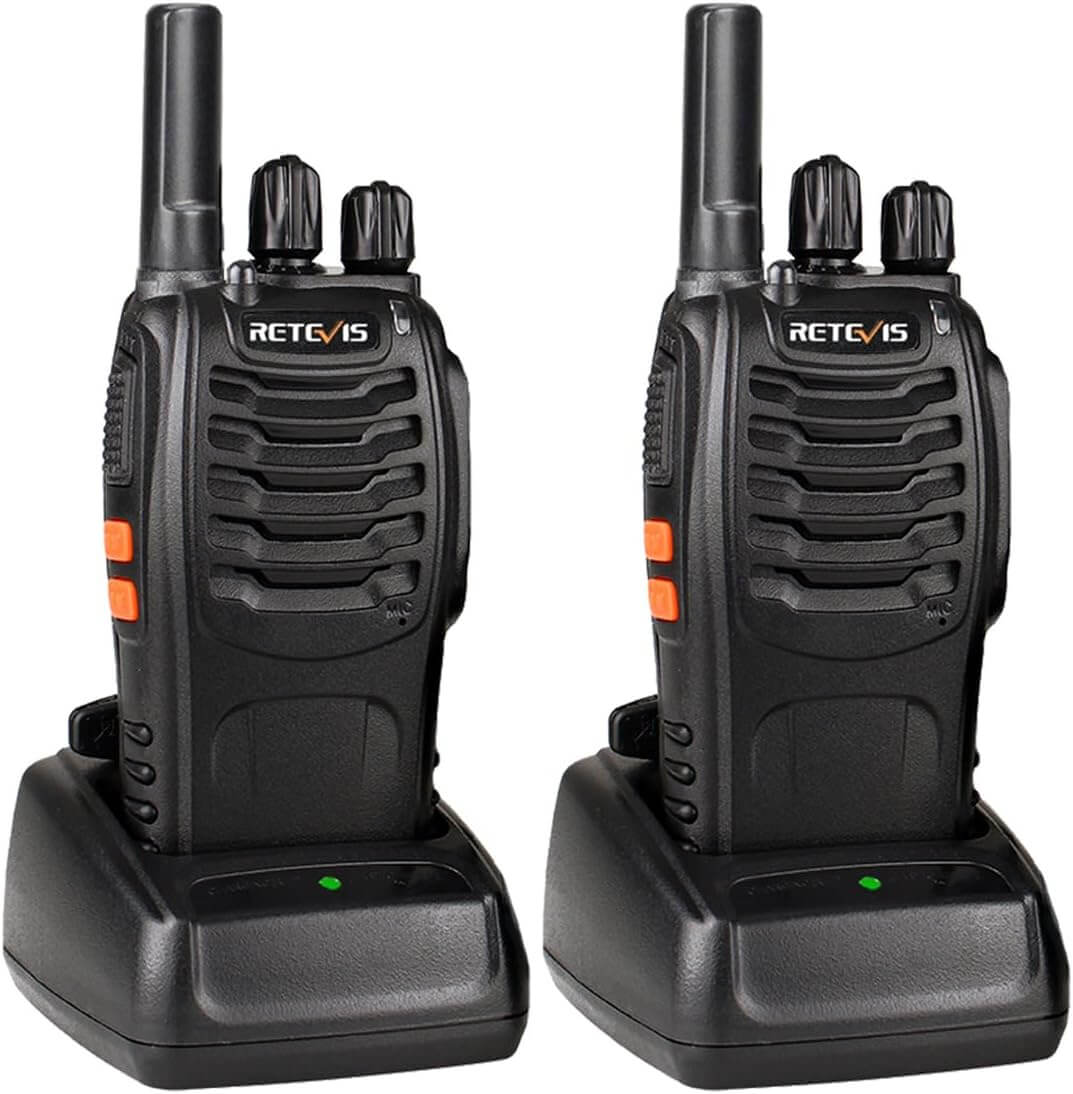
These radios feature a simple push-to-talk operation, making them very user-friendly. Their compact design allows for easy handling, while their sturdy build enhances durability. Additionally, they come with a rechargeable lithium-ion battery that ensures a long-lasting power supply.
Another beneficial feature of the Retevis H-777 is its intelligent charging system, which automatically prevents overcharging. This extends battery life and enhances safety. Moreover, the radios come with a built-in LED flashlight for increased visibility in dark environments.
However, they lack a display, which could make operating them a bit challenging for some users. Another drawback is their somewhat limited range compared to other models. Nonetheless, for their price, they offer a great set of features and reliable performance.
- Clear, loud sound
- User-friendly operation
- Intelligent charging system
- Limited range
- Lacks a display
Retevis RT22 walkie-talkies
Retevis RT22 walkie-talkies are a compact and lightweight option that ensures easy communication while cruising. Despite their small size, they deliver a robust performance with clear sound quality. They also offer an impressive range, especially in open areas.
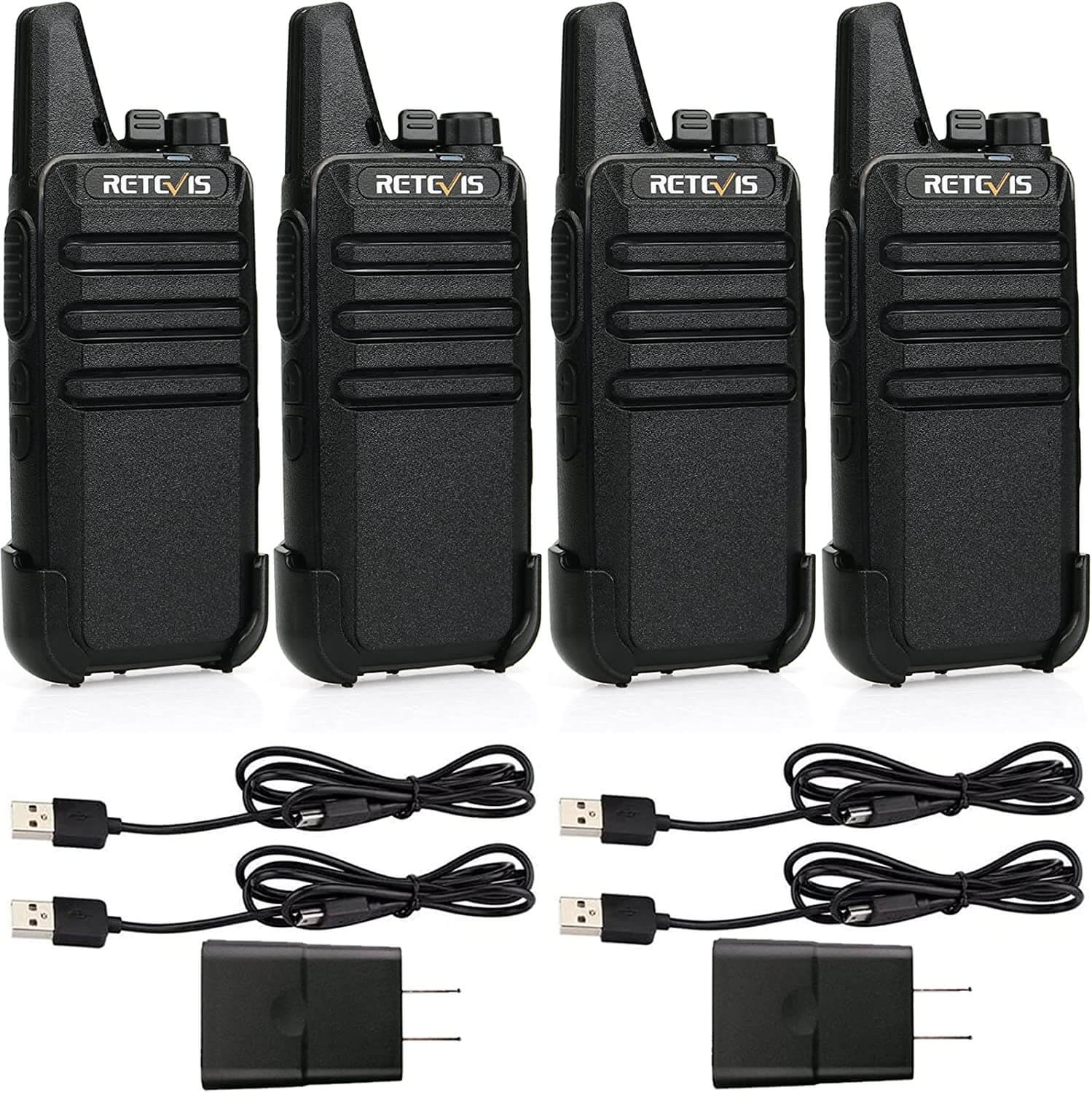
One of the standout features of the RT22 is its privacy codes system, which helps minimize interference from other users, thereby ensuring clear and private conversations. They also feature a hands-free function for more convenient use.
The radios come with a rechargeable battery and a power-saving feature that extends battery life. Their solid build makes them durable, while their compact design makes them easy to carry around. Plus, they come with a USB charging cable for more charging convenience.
However, the RT22 walkie-talkies come with a fixed antenna, which can limit their range in certain environments. Nonetheless, for their compact size, affordability, and the functionality they provide, they make a decent choice for cruise ship communications.
- Compact and lightweight
- Privacy codes system
- Fixed antenna
Retevis RT49P Waterproof Walkie Talkies
Retevis RT49P Waterproof Walkie Talkies are an excellent choice for those prioritizing durability and resistance to harsh conditions. With their IP67 waterproof rating, these radios can withstand being submerged in water, which is a useful feature during sea voyages.
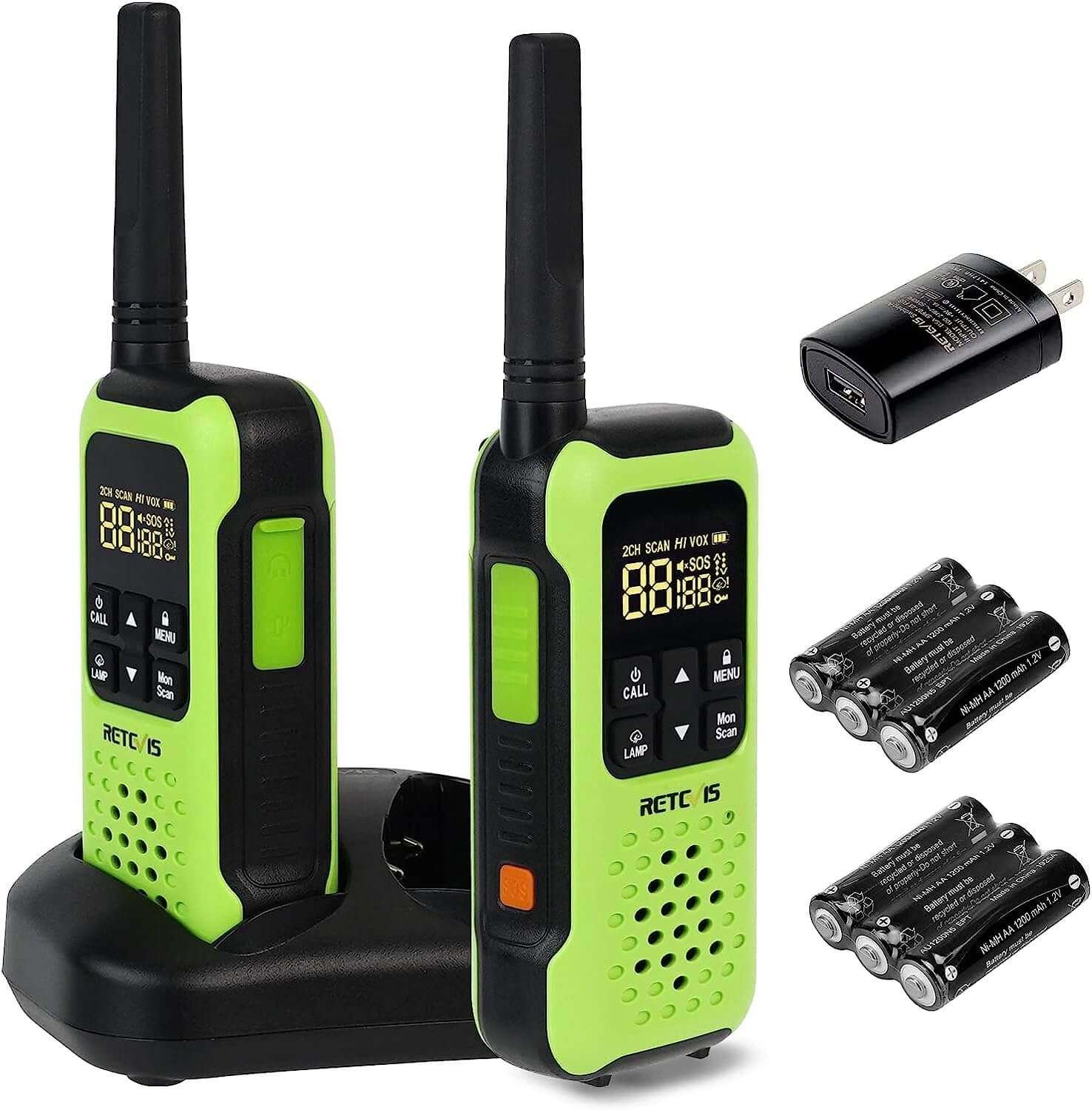
The RT49P walkie-talkies offer a commendable range for clear communication, with 22 channels and 121 privacy codes to minimize interference from other users. They feature a large backlit LCD screen, making them easy to operate even in low-light conditions.
These radios also come with a rechargeable battery and a power-saving feature. They’re equipped with a dual watch that allows monitoring of two channels simultaneously. A built-in flashlight and emergency alarm further enhance their utility.
On the downside, their size and weight are a bit on the larger side, which may not be ideal for users looking for more compact models. However, their ruggedness, long-range capabilities, and waterproof feature make them a solid choice for use on cruise ships.
- Long-range capabilities
- Large backlit LCD screen
- Dual watch feature
SANZUCO Long Range Walkie Talkies
SANZUCO Long Range Walkie Talkies stand out for their remarkable long-range communication, making them ideal for use on large cruise ships. They feature 20 channels and an impressive 30-mile range in open areas, ensuring clear and uninterrupted communication.
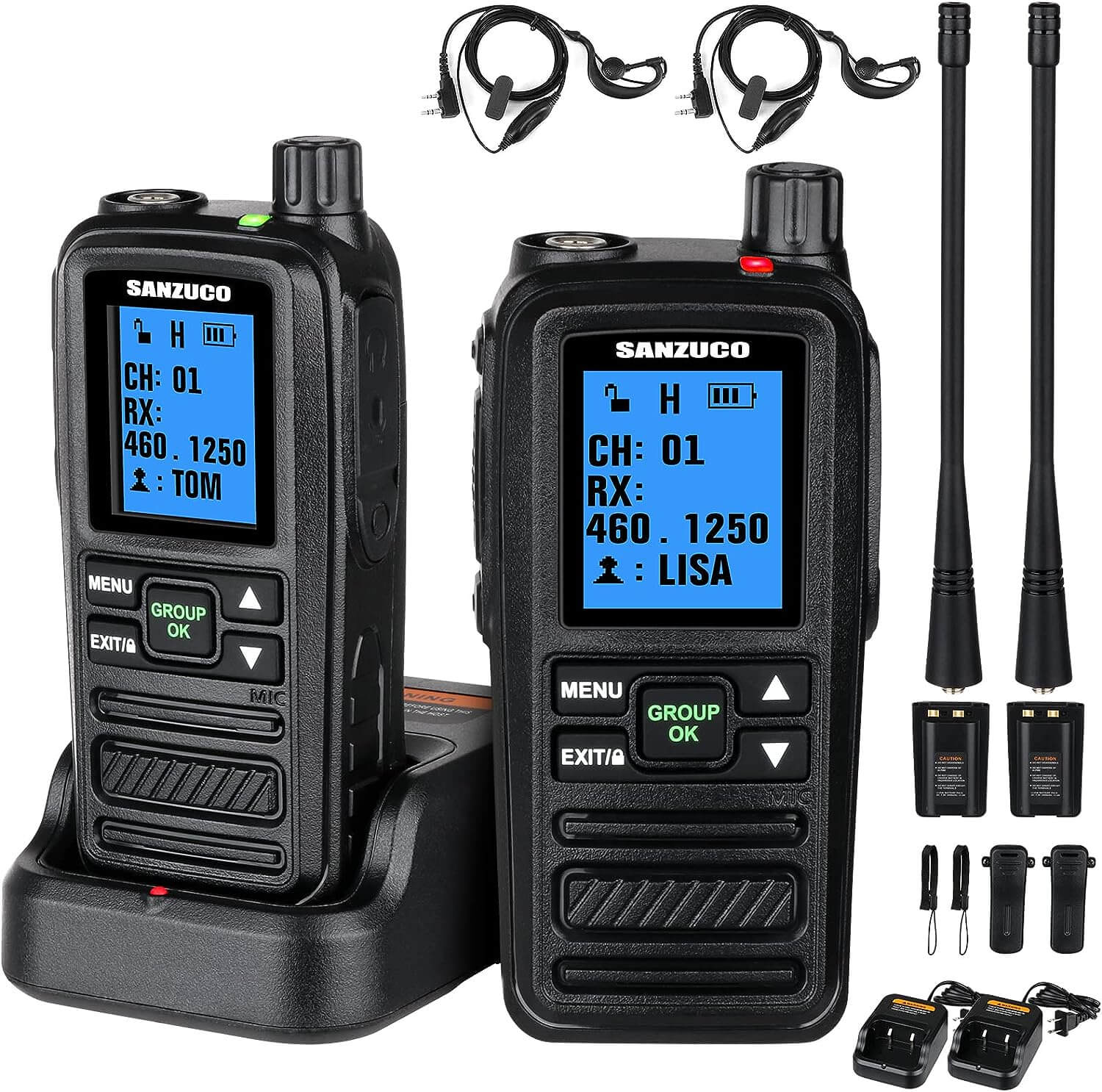
These walkie talkies come with a large backlit display for easy navigation. Their robust construction guarantees durability, and they are also dust and waterproof, offering extra protection in the harsh sea environment.
Another impressive feature of the SANZUCO walkie talkies is their 3000mAh rechargeable battery, which provides an extended power supply, reducing the frequency of recharges. Moreover, they offer a voice companding function, which ensures clear sound quality even in noisy environments.
However, their range can significantly reduce in built-up areas or through walls. Nevertheless, their extended battery life, robust build, and long-range make them an excellent option for cruising.
- Large backlit display
- Robust waterproof construction
- Extended battery life
- Range reduces in built-up areas
MOICO walkie-talkie Set
The MOICO walkie-talkie Set provides reliable and efficient communication with its 22 channels and 5-mile range in open areas. These radios are perfect for cruise ship use, thanks to their robust construction and easy-to-use features.
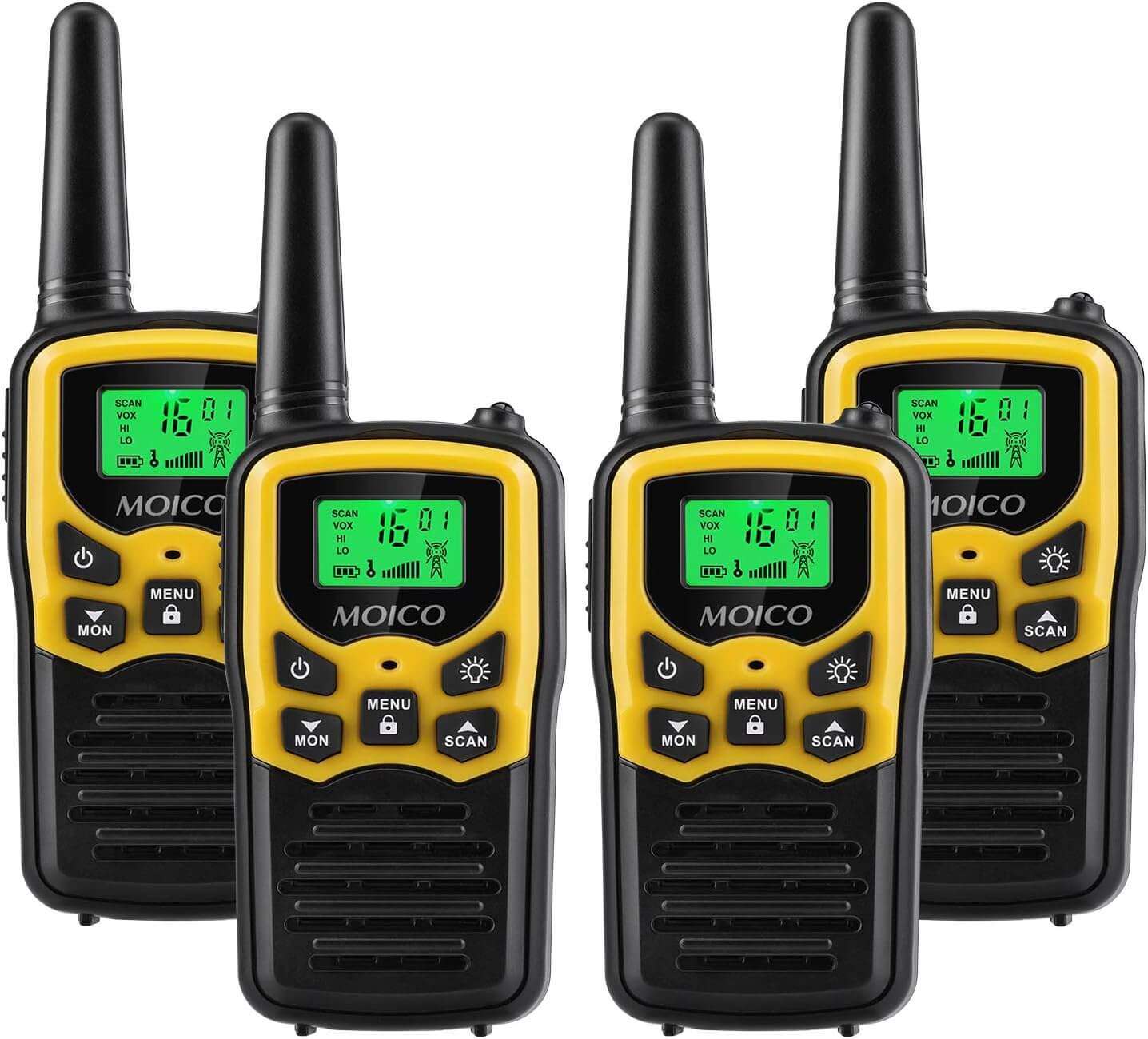
One of the key attributes of the MOICO walkie-talkie set is its clear sound quality, backed by an adjustable volume level and an automatic squelch system to mute background noise. These radios also support voice-activated transmission for hands-free operation.
The radios come with a rechargeable battery and a power-saving mode that extends battery life. They also feature a built-in flashlight, which can be handy during night-time activities or emergencies. The radios are compact and lightweight, making them easy to carry around.
A potential drawback is that their range significantly decreases with obstacles, which can be a challenge in the complex environment of a cruise ship. Despite this, they offer excellent value with their clear sound, compact design, and hands-free operation.
- Clear sound quality
- Voice-activated transmission
- Power-saving mode
- Range decreases with obstacles
Midland GMRS Two-Way Radio
Midland GMRS Two-Way Radios are professional-grade radios that offer high performance and extensive range, making them perfect for cruise ships. With their 36 channels and up to 30-mile communication range in open areas, these radios ensure clear and reliable communication.
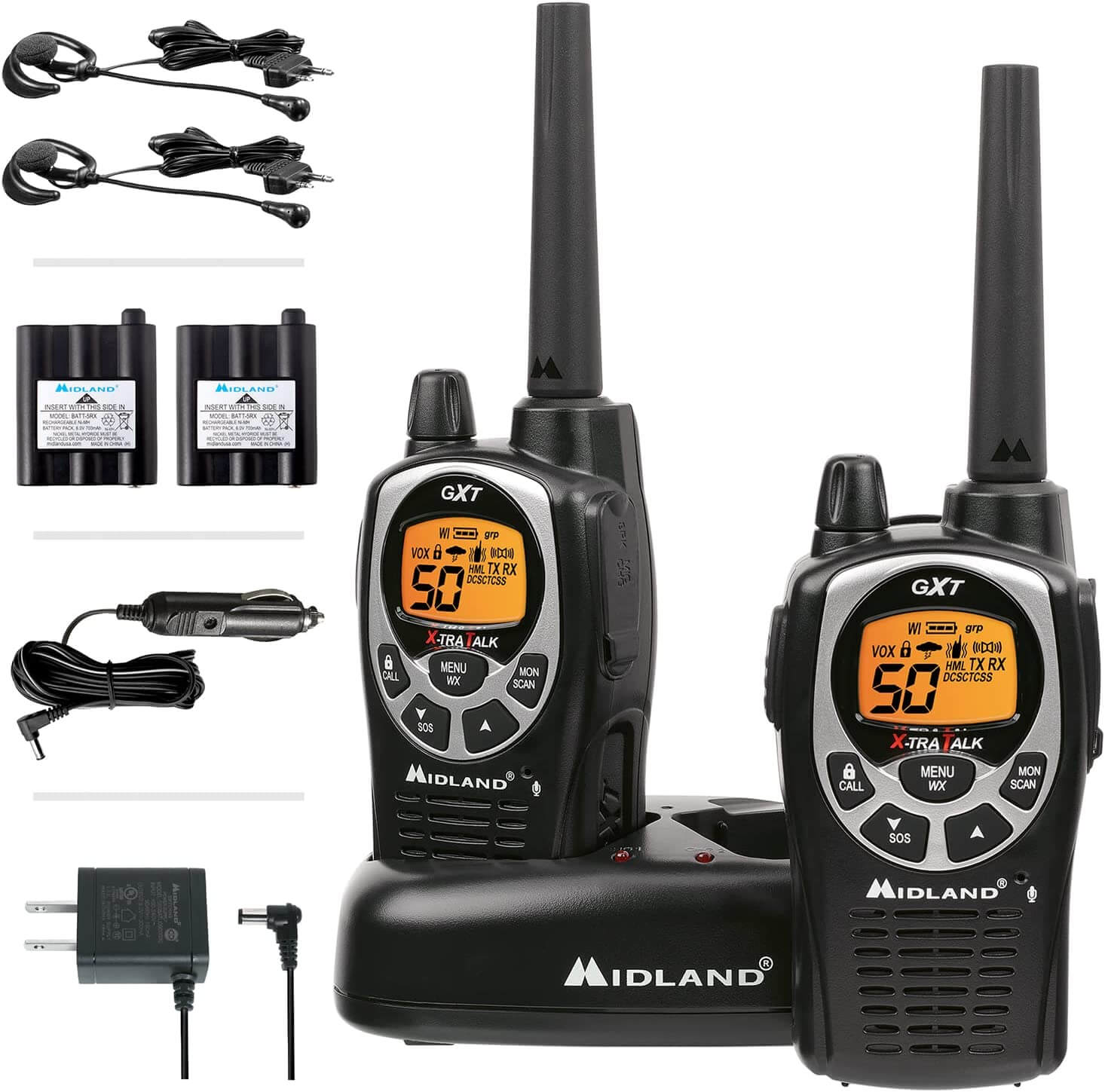
These radios feature 142 privacy codes for secure conversations. They also provide NOAA weather alerts, which can be extremely helpful during sea voyages. Their water-resistant design provides added durability and protection in marine environments.
The radios offer a dual power option, allowing the use of rechargeable batteries or 4 “AA” batteries, ensuring they remain powered during your cruise ship adventure. A potential downside, however, is their high price point, making them more suitable for users who prioritize high performance over budget.
Despite their price, the Midland GMRS Two-Way Radios’ professional-grade features, extensive range, and durability make them an excellent choice for cruise ship use.
- Extensive range
- 142 privacy codes
- NOAA weather alerts
- Water-resistant design
- High price point
Pxton Walkie-Talkies
pxton walkie-talkies are designed with simplicity and functionality in mind. They offer a range of up to 6 miles in open areas, making them suitable for communication on a cruise ship. These radios provide 22 channels and privacy codes to minimize unwanted interference from other users.
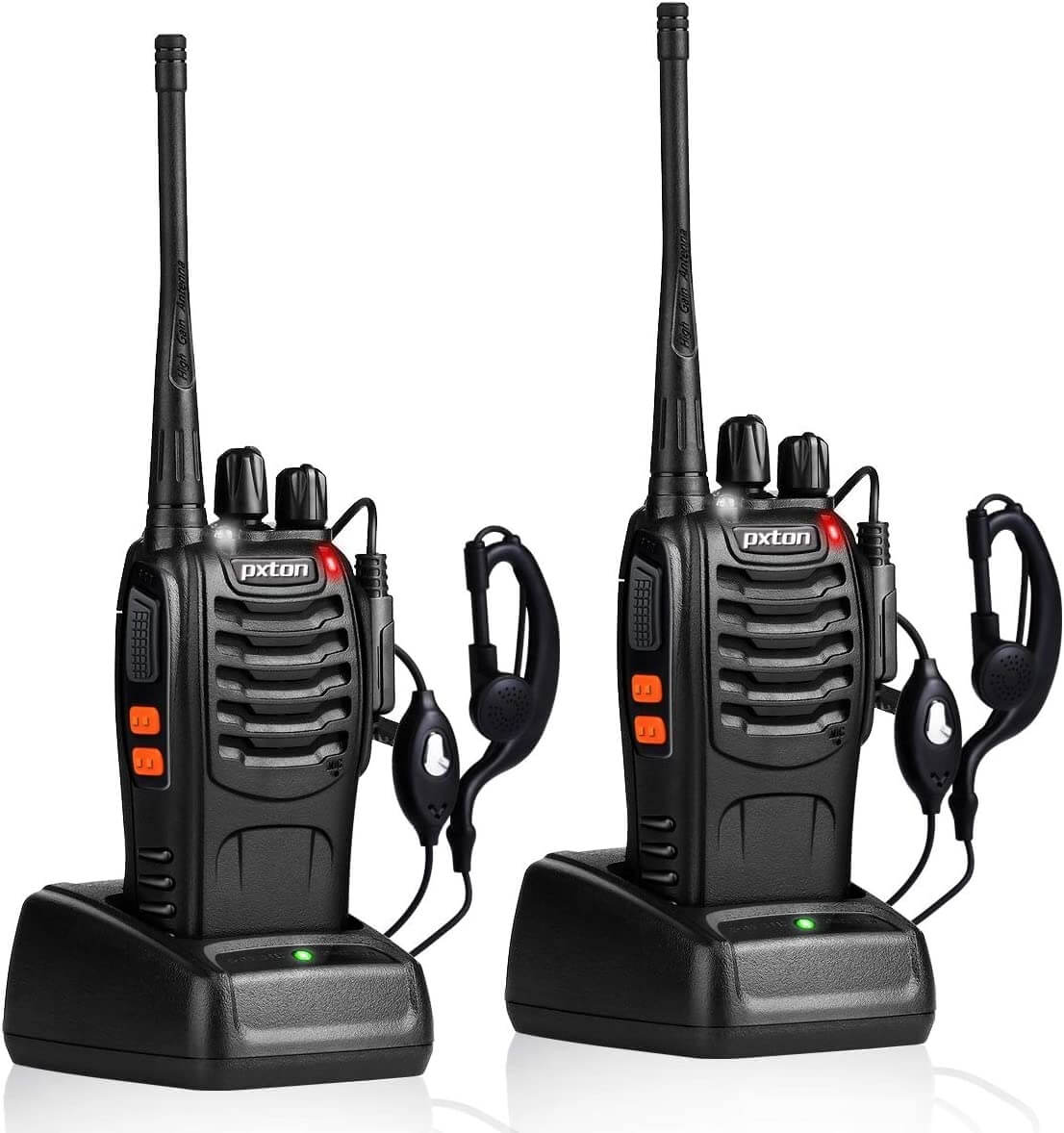
A significant advantage of the pxton walkie-talkies is their lightweight and compact design, making them easy to carry around. They feature a backlit LCD screen for easy operation even in low-light conditions. Additionally, they come with a hands-free function for more convenient use.
These radios are powered by a rechargeable battery that guarantees a long power supply. However, their range can significantly reduce in areas with obstacles. Nevertheless, their compactness, clear sound, and easy operation make them a good choice for cruising.
- Lightweight and compact
- Backlit LCD screen
- Hands-free function Affordable
Topsung 2 Way Radios Walkie Talkies
Topsung 2 Way Radios Walkie Talkies offer a great mix of affordability and performance. With their range of up to 3 miles in open areas and 22 channels, they deliver clear and reliable communication, essential for a cruise ship environment.
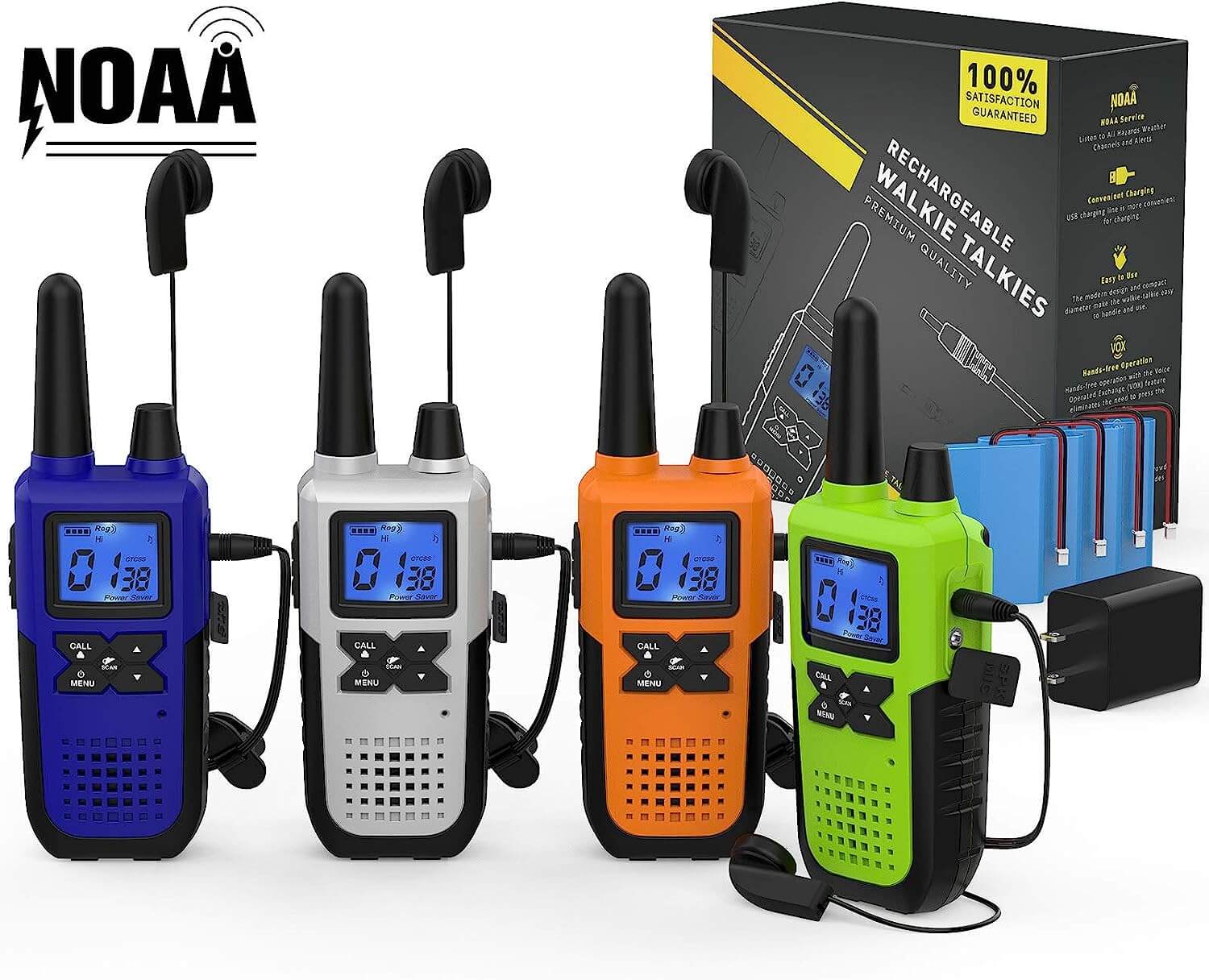
One of the main features of these radios is their compact and ergonomic design, which makes them easy to handle and operate. They also have a built-in flashlight, a useful feature during emergencies or when in low-light conditions.
These walkie-talkies are powered by 3 AAA batteries and come with a power-saving function to extend battery life. On the downside, their range significantly reduces in areas with obstructions. Still, their affordability, ease of use, and reliability make them a good pick for casual cruisers.
- Compact and ergonomic design
- Built-in flashlight
- Power-saving function
- Range decreases in obstructed areas
Motorola T200
The Motorola T200 is a popular choice for cruise ship communication, thanks to its excellent performance and reliability. The radios offer a wide range of up to 20 miles in open areas and 22 channels, ensuring clear and uninterrupted communication.
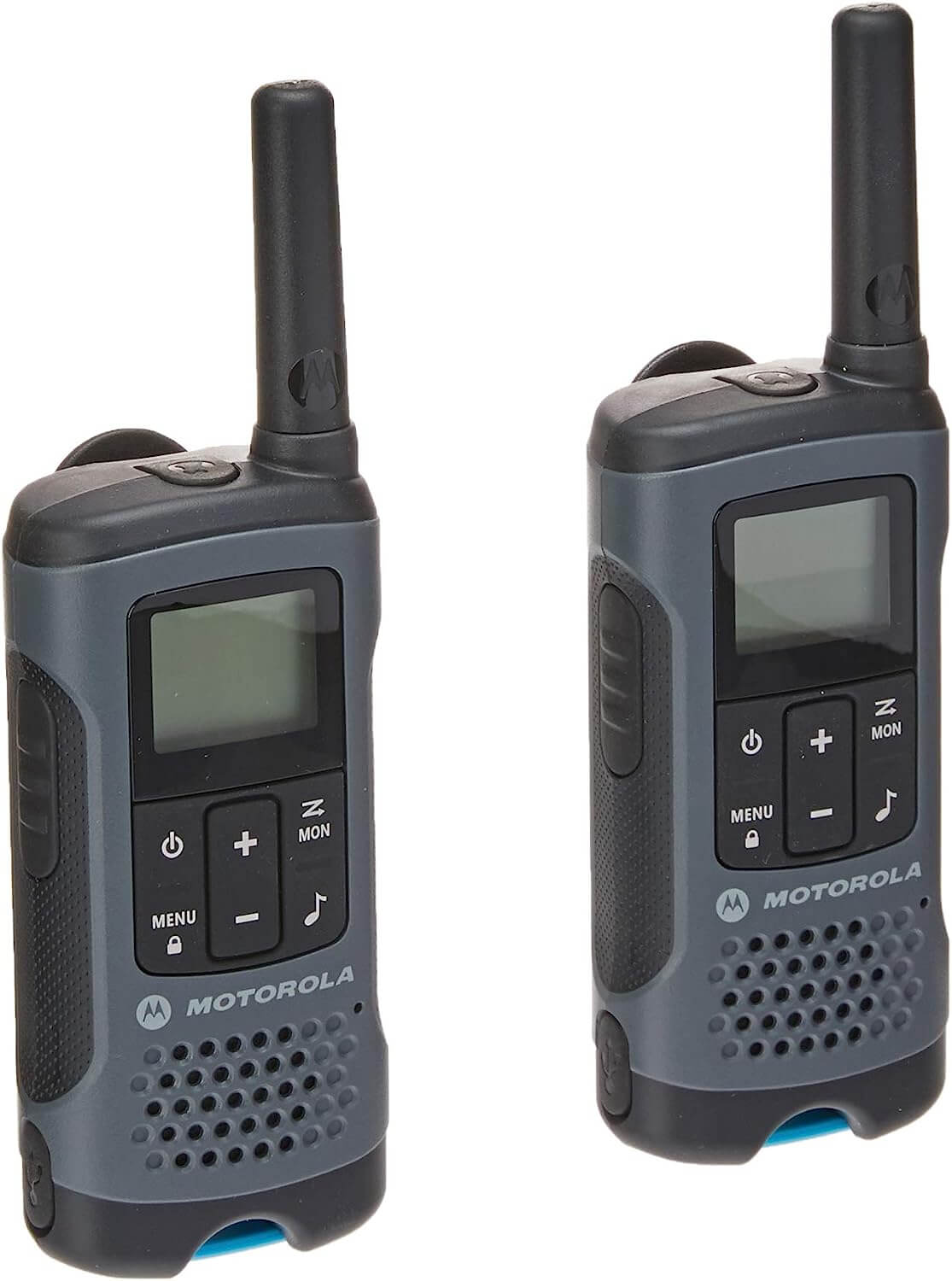
These radios come with a dual power option, allowing the use of rechargeable batteries or 3 “AA” batteries. They also offer a low battery alert for timely battery replacement or recharging. An additional feature is the quiet talk function that helps eliminate interference from non-Motorola radios.
However, like many radios, their range can significantly reduce in built-up areas or through walls. Despite this, the Motorola T200’s extended range, dual power option, and clear sound make them a solid choice for use on cruise ships.
- Wide range communication
- Dual power option
- Low battery alert
- Quiet talk function
Baofeng BF-888S
The Baofeng BF-888S walkie-talkies are another noteworthy option for cruise ship communication. With a range of up to 6 miles in open areas, these radios provide a reliable communication channel. They come with 16 memory channel presets, adding to their usability.
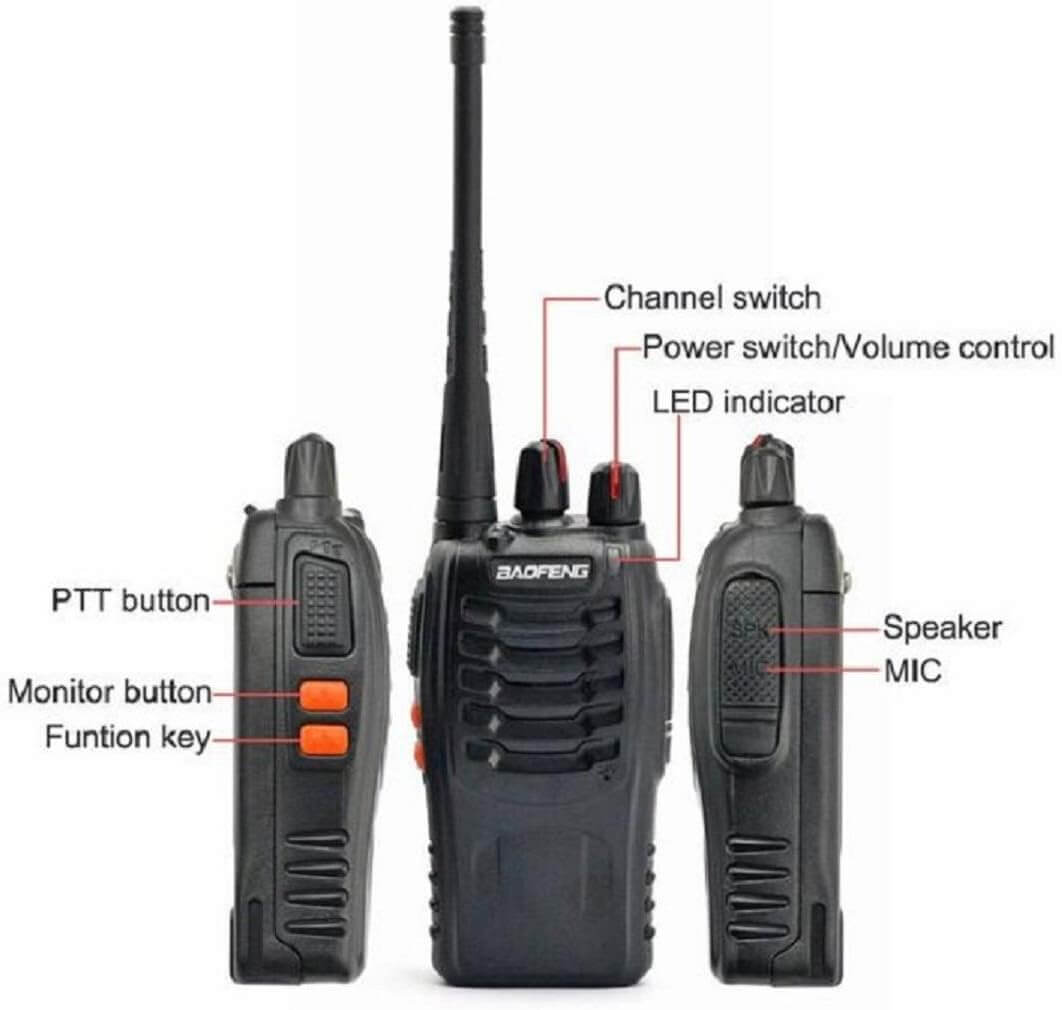
One of the standout features of the BF-888S is the power-saving function, which considerably extends the battery life, making these radios suitable for long cruises. They also come with a built-in LED torch that provides light in dark environments or during emergencies.
These radios are powered by a rechargeable 1500mAh Li-ion battery, which offers a long operating time. However, their range can decrease significantly in obstructed areas. Despite this, their long battery life, built-in LED torch, and clear sound make them a strong contender for the best walkie-talkies for cruise ships.
- Long battery life
- Built-in LED torch
- Power-saving function Affordable
Motorola T100 Talkabout Radio
The Motorola T100 Talkabout Radio is another excellent product from Motorola that offers reliable communication in the cruise ship environment. The radios offer 22 channels and have a range of up to 16 miles in open areas, ensuring clear and uninterrupted communication.
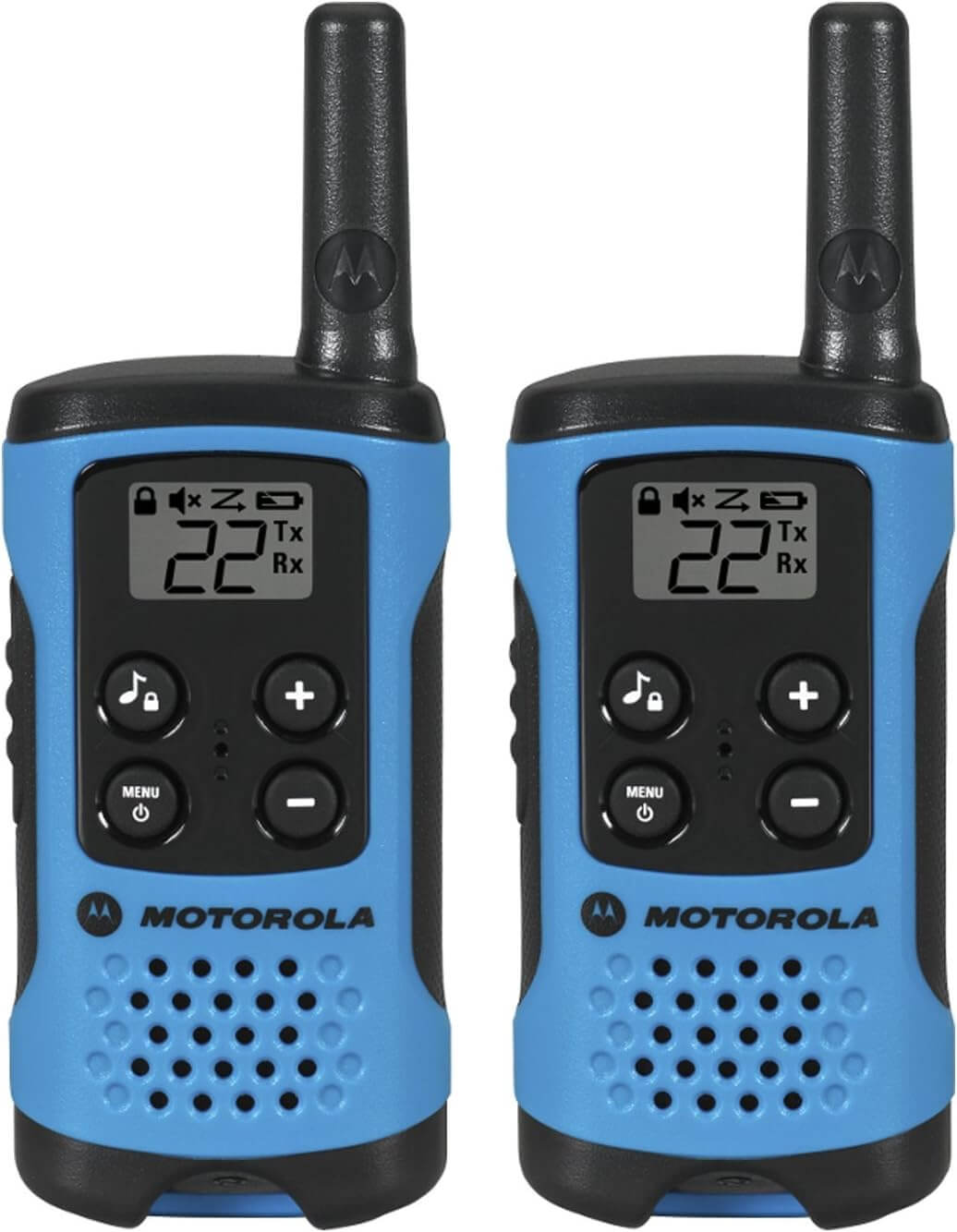
These radios are compact and lightweight, making them easy to carry around. They come with a simple push-to-talk operation and are very user-friendly. The radios also feature a keypad lock that prevents accidental changes to the settings.
The radios are powered by 3 AAA batteries, and they come with a low battery alert for timely battery replacement. However, the range of these radios can significantly decrease in areas with obstacles. Still, their compact design, user-friendly operation, and clear sound make them a valuable addition to your cruise ship journey.
- Keypad lock Affordable
Cobra RX680
The Cobra RX680 radios are designed for performance and durability. With a range of up to 38 miles in open areas, they provide one of the most extended ranges among walkie-talkies, making them perfect for cruise ship communication.
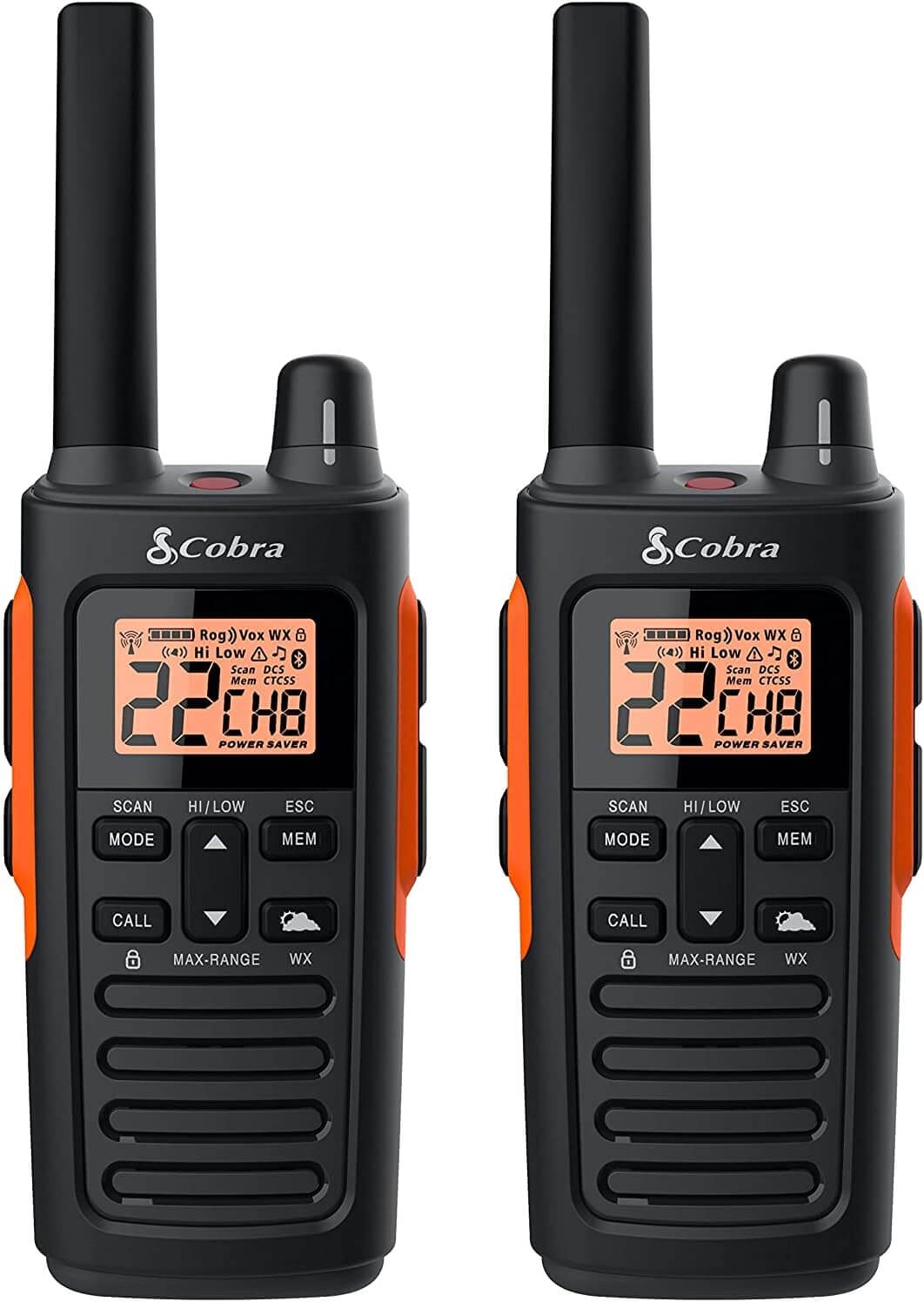
These radios come with a waterproof design that offers excellent durability in the harsh sea environment. They provide 2662 channel combinations and 121 privacy codes, minimizing the chances of interference from other users.
These radios are powered by a rechargeable battery and come with a micro-USB charging cable for convenience. They also offer NOAA weather alerts, which can be helpful during sea voyages. However, their range can significantly decrease in obstructed areas. Nonetheless, their extended range, durability, and clear sound make them an excellent choice for use on cruise ships.
- Extended range
- Waterproof design
- 2662 channel combinations and 121 privacy codes
Cruise Ship Walkie-Talkie FAQ
Can walkie-talkies interfere with ship communications.
Walkie-talkies can potentially interfere with ship communications if they operate on the same frequencies. This is one of the reasons why some cruise lines restrict the use of devices with certain frequency ranges. Always ensure to use your device respectfully, following any guidelines provided by the cruise line to prevent any unintentional interference.
How effective is the range of walkie-talkies on a cruise ship?
The range of walkie-talkies on a cruise ship can be impacted by a variety of factors. These devices usually operate best in open areas with minimal obstructions. Since cruise ships are multi-level structures filled with various materials, radio waves can get absorbed, reflected or scattered. As a result, the effective range of a walkie-talkie onboard might be less than its maximum stated range.
However, high-quality devices can still be pretty effective. On average, a good walkie-talkie with a range of 35 miles on land may provide a reliable communication link across several miles on a cruise ship.
What are the legal implications of using walkie-talkies on international waters?
Using walkie-talkies on international waters generally falls under the jurisdiction of the International Telecommunication Union (ITU). According to the ITU’s Radio Regulations, radio communication equipment like walkie-talkies should not cause harmful interference and should accept any interference received.
Furthermore, the use of certain frequency bands could be restricted or require a license. It’s recommended to check with the manufacturer or your cruise line to ensure your device complies with relevant regulations.

How can I increase the range of my walkie-talkie on a cruise ship?
The range of your walkie-talkie on a cruise ship is determined by multiple factors including the device’s power output, the frequency it operates on, and the surrounding environment. While you cannot modify your device’s specifications, there are a few strategies you can use to potentially increase your device’s range:
- Use a Higher Channel: Higher frequencies have shorter wavelengths and are less likely to be absorbed by obstacles. Try switching to a higher channel, if possible.
- Position Yourself Higher: The higher up you are, the less obstructed your signal will be. If you’re having difficulty reaching someone, try moving to a higher deck.
- Avoid Obstacles: Large metal objects and electrical equipment can interfere with radio signals. Try to avoid these when using your walkie-talkie.
Can walkie-talkies work without a signal or network?
Yes, walkie-talkies do not require a cellular network or internet connection to work. They communicate directly with each other using radio waves. As long as the devices are within range and operating on the same frequency, they can communicate, making them ideal for use in areas with poor or no network coverage, like on a cruise ship.
How do walkie-talkies compare to mobile phones for communication on a cruise ship?
Walkie-talkies and mobile phones both have their own advantages and disadvantages when it comes to communication on a cruise ship. Here’s a comparison table:
While walkie-talkies provide a convenient and reliable mode of communication, mobile phones offer the ability to communicate beyond the ship and access various other services like internet and apps.
Can walkie-talkies pick up signals from the ship’s communication system?
Walkie-talkies are generally not capable of picking up signals from the ship’s communication system. Cruise ships use specialized communication equipment that operates on different frequencies and protocols than consumer walkie-talkies.
Furthermore, attempting to tap into the ship’s communication system could potentially interfere with crucial operations and is likely against the cruise line’s policies.
Can other passengers listen in on my walkie-talkie conversations?
Yes, it’s possible for others to listen in on your walkie-talkie conversations if they are on the same channel. To maintain privacy, it’s recommended to select a less crowded channel, keep conversations brief and to the point, and avoid sharing sensitive information over the radio.
Some walkie-talkies come with privacy codes or sub-channels that can provide an extra layer of privacy. However, these aren’t foolproof as anyone with a similar device can potentially access these sub-channels.
In the subsequent sections, we’ll continue to delve deeper into questions related to the use of walkie-talkies on cruise ships.
How to charge walkie-talkies on a cruise ship?
Charging your walkie-talkies on a cruise ship is generally straightforward. Most modern walkie-talkies come with rechargeable batteries and a charging base. You simply need to plug the base into an electrical outlet and place the walkie-talkies on the base to charge. It’s worth noting that the electrical outlets on a cruise ship are the same as you would find in a typical home, so you won’t need any special adapters or converters.
However, always remember to:
- Check the voltage of your device and compare it with the cruise ship’s supply to avoid damaging your device.
- Bring along extra batteries for devices that use disposable batteries.
What is the average battery life of walkie-talkies on a cruise ship?
The average battery life of walkie-talkies can vary depending on the model and how they’re used. Typically, walkie-talkies can last between 8 to 20 hours on a single charge. Factors such as the power output, how often the device is used, and whether features like backlighting or GPS are used can impact battery life.
To prolong the battery life:
- Turn off any unnecessary features.
- Reduce the power output if you’re communicating over short distances.
- Use power-saving modes, if available.
How do walkie-talkies affect other electronic devices on a cruise ship?
In general, walkie-talkies do not significantly affect other electronic devices. They emit radio waves, not unlike many other electronic devices, and are designed to comply with regulations that limit their interference with other electronics.
However, it’s possible for any electronic device to cause minor interference if it’s very close to another device. For instance, you might hear a buzzing sound from a speaker if a walkie-talkie is used very close to it. This type of interference is usually minor and stops as soon as the walkie-talkie is moved away from the affected device.
What features should I look for in a walkie-talkie for a cruise ship?
When shopping for a walkie-talkie for a cruise ship, consider the following features:
- Range: Look for a device with a high range to ensure reliable communication across the ship.
- Battery Life: Longer battery life means less frequent charging.
- Channels: More channels mean less chance of interference and more private conversations.
- Durability: Consider a device that is shock-resistant and waterproof for durability.
- Privacy Codes: These can provide an extra layer of privacy for your conversations.
- Clarity: Look for devices that offer clear sound quality.
- Size and Weight: Consider the size and weight of the device, especially if you plan to carry it around all day.
With this information, you should be well-equipped to select the perfect walkie-talkie for your next cruise ship adventure.
Understanding the role and effectiveness of walkie-talkies on a cruise ship can significantly enhance your cruising experience.
While they can’t replace the ship’s communication systems, they offer an additional layer of communication especially beneficial for larger groups or families.
Hopefully, this guide has provided insightful answers to the most common questions related to the use of walkie-talkies on cruise ships. Happy cruising!
More Reading...
- Best Adventure Travel Blogs
- Best Travel Bras
- Best Travel Humidors
- 47 of the Best Family Travel Blogs
- Best Travel Tea Sets
- Best Travel Money Belts
Dan Claydon
Cruise Line Scanner Frequencies
Fri 3rd Jan 2014, 12:06pm
Cruise Line Scanner Frequencies 468.3250----CARNIVAL CRUISE LINES 151.7450----CARNIVAL CRUISE LINES - MIAMI 151.9250----CARNIVAL CRUISE LINES - MIAMI 154.5150----CARNIVAL CRUISE LINES - MIAMI 154.5400----CARNIVAL CRUISE LINES - MIAMI 156.2750----CARNIVAL CRUISE LINES - PORT OPS - CH 65 156.8000----CARNIVAL CRUISE LINES - CALLING/DISTRESS CH 16 156.9000----CARNIVAL CRUISE LINES - COMMERCIAL - CH 18 156.9500----CARNIVAL CRUISE LINES - COMMERCIAL - CH 19 462.1750----CARNIVAL CRUISE LINES - OPS - CH 1 472.5375----CARNIVAL CRUISE LINES - OPS - CH 1 - PEMBROKE PINES 464.5000----COMMODORE CRUISE LINES - MIAMI 855.5375----DISCOVERY TOURS - ORLANDO 156.5500----EASTERN CRUISE LINES 461.6000----FELCER TOURS - MIAMI 151.9250----GO VACATIONS - MIAMI
461.1750----HOLLAND AMERICA LINE WESTOURS - FT.LAUDERDALE 461.5000----HOLLAND AMERICA LINE WESTOURS - FT.LAUDERDALE 469.4125----INNOVATIVE CHARTERS - ST.PETERSBURG 156.4500----NORWEGIAN CARIBBEAN CRUISE LINES 156.9750----NORWEGIAN CARIBBEAN CRUISE LINES 457.5250----NORWEGIAN CARIBBEAN CRUISE LINES 469.0125----NORWEGIAN CARIBBEAN CRUISE LINES - MIAMI 156.5500----OFFSHORE MARINE TOWING - CH 11 464.3250----PREMIER CRUISE LINES - CAPE CANERVAL 464.8125----PREMIER CRUISE LINES 151.7450----REGENCY CRUISES 151.8650----REGENCY CRUISES 461.3100----ROYAL CARIB. CRUISE LINES - ENCHANTMENT OF THE SEAS 467.8250----ROYAL CARIB. CRUISE LINES - ENCHANTMENT OF THE SEAS 457.5500----ROYAL CARIB. CRUISE LINES - ENCHANTMENT OF THE SEAS 467.7750----ROYAL CARIB. CRUISE LINES - ENCHANTMENT OF THE SEAS 457.5750----ROYAL CARIB. CRUISE LINES - ENCHANTMENT OF THE SEAS (R) 467.8000----ROYAL CARIB. CRUISE LINES - ENCHNTMT...SEAS (R)INPT 467.5500----ROYAL CARIB. CRUISE LINES - ENCHANTMENT OF THE SEAS 156.6000----ROYAL CARIB. CRUISE LINES - ENCHANTMENT/MAJESTY 467.0000----ROYAL CARIB. CRUISE LINES - ENCHANTMENT OF THE SEAS 467.0000----ROYAL CARIB. CRUISE LINES - ENCHANTMENT OF THE SEAS 461.3000----ROYAL CARIB. CRUISE LINES - ENCHANTMENT OF THE SEAS 467.9250----ROYAL CARIB. CRUISE LINES - ENCHANTMENT OF THE SEAS 462.0250----ROYAL CARIB. CRUISE LINES - MIAMI 463.3500----ROYAL CARIB. CRUISE LINES - MIAMI 457.5250----ROYAL CARIB. CRUISE LINES - MAJESTY OF THE SEAS 457.5500----ROYAL CARIB. CRUISE LINES - SONG OF NORWAY 156.5000----SEA ESCAPE LIMITED 156.5500----SEA ESCAPE LIMITED 156.8000----SEA ESCAPE LIMITED 151.8350----SUNCOAST CRUISE 464.5000----TROPIC CRUISE LINES - MIAMI 464.6000----TROPIC CRUISE LINES - MIAMI 156.4250----WINDJAMER BAREFOOT CRUISES 156.4500----WINDJAMER BAREFOOT CRUISES Princess Cruises Scanner Frequencies 161.4500----ISLAND PRINCESS - LA, CA. - F1 - CAPTAIN TO CREW 161.3500----ISLAND PRINCESS - LA, CA.- F2 - PRINCESS SHORE TOURS 156.8000----ISLAND PRINCESS - LA, CA.- F3 - CHANNEL 16 156.3000----ISLAND PRINCESS - LA, CA.- F4 - CHANNEL 6 469.9250----ISLAND PRINCESS - LA, CA.- PRINCESS PAGING 049.1650----ISLAND PRINCESS - LA, CA.- SHIP GENERATED CARRIER 169.2450----ISLAND PRINCESS - LA, CA.- WIRELESS MIC 167.3950----ISLAND PRINCESS - LA, CA.- WIRELESS MIC 168.0000----ISLAND PRINCESS - LA, CA.- WIRELESS MIC 156.3000----ROYAL PRINCESS - LA, CA.- CH 06 INTERSHIP 156.7500----ROYAL PRINCESS - LA, CA.- CH 15 SHIP TO TENDERS 156.8000----ROYAL PRINCESS - LA, CA.- CH 16 EMERGENCY 161.4500----ROYAL PRINCESS - LA, CA.- F1 - REPEATER LINKED 161.3500----ROYAL PRINCESS - LA, CA.- F2 457.5500----ROYAL PRINCESS - LA, CA.- REPEATER FOR ONBOARD
Quick search
© 2024 ScannerFrequencies.com. Terms and Conditions | Privacy | Cookie Policy | Contact
ScannerFrequencies is a participant in the Amazon Services LLC Associates Program, an affiliate advertising program designed to provide a means for sites to earn advertising fees by advertising and linking to Amazon.com.

Do Walkies Talkies Work On A Cruise Ship?
Cruising with family is undoubtedly a fantastic experience, but staying connected in those bustling cruise ship crowds can be a bit challenging.
Cruise lines offer a solution to this issue with WiFi or cruise apps . However, many cruisers don’t want to pay for these services and choose two-way radios or walkie-talkies to stay in touch with their family. The question is, do they work on cruise ships?
The answer is Yes, walkie-talkies work on cruise ships, but it’s like chatting with a friend in a busy market; sometimes clear, sometimes not. Their effectiveness depends on the obstructions in your communication path .
So stay connected with me till the end to find out if walkie-talkies are worth it on cruise ships and on which areas of the ship they work best and worst.
So let’s get started.
Table of Contents
Do Walkie Talkies Work on Cruise Ship?
Yes, walkie-talkies do work on cruise ships, but their effectiveness depends on several factors, including the specific part of the cruise ship and potential obstructions.
But let’s admit it: they’re the best communication alternative to Wi-Fi and Cruise apps, as long as you know how to use them correctly use it.
I realized their effectiveness when I observed cruise staff using them as their primary mode of communication. They are convenient.
However, there are some things to consider, such as the obstacles that hinder the handsets’ two-way communication.
But don’t worry. In the next section of the guide, I’ll discuss the best and worst cruise ship areas for walkie-talkies, which will help you make the most of them.
Walkie Talkies Hands-On Experience On Different Cruise Ship Areas
To help you make the best decision possible, I tested walkie-talkies in various cruise ship areas to see how they perform.
From the test observations, I found that you can even communicate with the person on the opposite end of the ship when the communication path has few to no obstructions.
Here are the results from some ship areas where I conducted hands-on tests with walkie-talkie.
1- Using A Walkie Talkie Inside The Cabin
Using a walkie-talkie inside the cabin is only effective when the other person you want to communicate with is outside the hallway; then, the communication can be clear.
Communicating inside the cabin or balcony with a person on the above deck can create a problem. This communication may frustrate you as sometimes you’ll hear and sometimes not. And it’s all because of various obstructions such as walls, beds, ceilings, and metal posts.
As you might know, there’s no rocket science in this result that the cabins block the signals due to the steel decks, walls, and ceiling.
So, it’s clear that a walkie-talkie will not work if you want to communicate with the person above deck or somewhere else from your room.
However, if it’s necessary for you, try using the Ultra High-Frequency (UHF) walkie-talkie. But I don’t suggest it because many factors can also affect the device range.
2- Using A Walkie Talkie Outside The Cabin
As mentioned earlier, if there are no obstructions in the communication path, it will be clearer.
Using the two-way radio outside the cabins will create no problem.
So, if you are swimming in the pool located at the end of the ship and want to communicate with the member taking a sunbath at the other end, there’s no doubt you can still keep in touch with each other through these devices.
So, if your needs are in the outside areas of the ship, a walkie-talkie can be an ideal choice.
3- Communicating From The Top Deck With Person On The Bottom Of The Ship
In this situation, a walkie-talkie can encounter a slight communication issue.
It’s because the decks can be a minor obstruction to the signal. So, communication may not be as clear.
But yes, if you’re communicating from the top deck to the person on the deck below (even two decks below), it will be clear as long as the person is still outside the cabin.
So communicating with the person on the below decks is not an issue as long as it is within the device’s range capacity.
4- Using A Walkie Talkie On The Top Deck
If your needs are on the top deck, look no further because the top deck is one of the best spots to use a walkie-talkie.
If both end users are on the top deck, they can communicate without interruptions, even on the largest cruise ship, no matter how far they are from each other.
The top deck has fewer obstacles and provides a visible sight line, allowing the handheld sets to work properly.
Best And Worst Ship Areas For Walkie Talkies
From the above results, you might know which areas are best and worst for walkie-talkies.
But if you’re still confused, here’s the list of best and worst ship areas for two-way radio:
Best Ship Areas:
- Outdoor Recreational Areas
Worst Ship Areas:
- Inside Cabins
- Enclosed Spaces
- Areas with Metal or Electronic Interference
What Makes Using a Walkie-Talkie Difficult On a Cruise Ship?
Walkie-talkies are great for cruise ships as long as there are few obstructions in the communication path.
The factors listed below are things that can make walkie-talkies difficult to function properly on cruise ships:
1- Communicating From The Cabin
The walkie-talkies can’t communicate from your cabin.
It’s only possible when the person is standing outside the room or in the hallway.
This is because of obstacles starting from the cabin, including walls, metals, steel, and other things.
So, cabin obstacles are the top factor, making it difficult for the walkie-talkies to communicate.
2- Electrical Interference
Electrical interference is also a major factor limiting the functionality of handheld devices.
The cruise ship is loaded with wiring and electronic devices that can interfere with the reception of a walkie-talkie, making it difficult to communicate.
3- Longer Distance
Remember, a longer distance means fewer signals.
Unlike a love relationship, which might increase with distance, the walkie-talkie works because a longer distance means fewer signals.
To overcome this issue, high-range or ultra-high-range two-way radio devices allow you to communicate over 500 feet apart.
4- Structural Interference
Last but not least, a cruise ship has a structure that walkie-talkies dislike the most.
It contains all kinds of obstacles to block the signal: thick walls, layers of steel framing, and electronic devices.
That’s why using a walkie-talkie on a cruise ship is best on a top deck or outside the cabin.
Are Walkie-Talkies Allowed On Cruise Ships?
Almost all cruise ships allowed walkie-talkies on board.
These include Royal Caribbean Cruise Line , Carnival Cruise Line, P and O Cruises, MSC Cruises, Disney Cruise Line , Princess Cruise , Virgin Voyages, Marella Cruise By TUI, and Holland America Line.
Which Cruise Line Doesn’t Allow Walkie Talkies Onboard?
Norwegian Cruise Line added Walkie Talkie to their list of 32 prohibited items.
There’s no explanation from the cruise line of why two-way radios are now prohibited, but there could be several reasons.
- Interference Concerns
- Disruption to passengers
- Promotion of onboard communication systems
- Security and safety considerations
- Noise management
Will The Walkie-Talkies Range Cover An Entire Ship?
As mentioned earlier, the Walkie Talkies range depends on the obstructions interfering with communication, and a cruise ship has many of them.
Also, it’s important to note that the range of two-way radios mentioned by the company must not be the same on a cruise ship as many factors limit its range.
In most cases, the device’s range covers an entire ship when the other person is outside the cabin or on the upper deck.
However, some obstructions remain, like doors, walls, electrical systems, passengers, and swimming pools. However, you can still use the walkie-talkie and be ready for the weak signals.
Are the frequency types for Walkie Talkies FRS, GMRS, or PMR446?
Walkie-talkies operate using radio signals, unlike network providers, including AT&T , and these signals come in various frequency types.
Different frequencies are assigned to specific named ranges for different services. For instance, a range of frequencies is reserved for FM radio and another set aside for television signals.
There are two major frequency types for walkie-talkies: Family Radio Service (FRS) and General Mobile Radio Service (GMRS).
FRS radios are ideal for shorter distances due to their lower-powered frequency range. On the other hand, GMRS radios have a higher frequency range, making them perfect for longer ranges.
Now, after understanding the concept of cruise ship obstructions, you should know which radio frequency devices will suit you the most.
But wait! You must know something about using GMRS inside and outside the US, which I’ve mentioned in the next section.
Laws Regarding The Use Of Walkie Talkie At Sea
The laws regarding the use of two-way radio at sea can be quite complicated in different countries.
But as far as Family Radio Service (FRS) is concerned, it’s alright.
The problem arises in the GMRS frequency. The GMRS walkie-talkies require a license to use in the USA and outside the USA due to their high range capability.
I suggest avoiding them and sticking to only FRS ones.
Also, research the rules and regulations of operating a walkie-talkie to prevent tapping into a foreign country’s public frequency, even if it’s an FRS channel.
What Type of Walkie Talkie Will Work on a cruise ship in the UK and Europe?
In the UK and Europe, a system similar to walkie-talkies is called PMR446. They operate on a frequency of 446 MHz in the UHF band for short-range communication.
Two years ago, I used this walkie-talkie during my sailing expedition through Ravana Cruise port . It offers a straightforward and hassle-free method to communicate wirelessly across short distances.
Below are some important things that you must know if you want to use two-way radios in the US, UK, and Europe:
- The UK model walkie-talkie can’t communicate with the US-purchased one as they are on two different radio frequencies.
- The two UK-purchased walkie-talkies can work in the USA, but they won’t be legal.
- Likewise, the two US-purchased devices can be used in the UK but won’t be legal.
Could Other People On the Ship Listen To Walkie Talkie Conversation?
Others on the ship can hear walkie-talkie talks because these devices use open frequencies.
Convos aren’t private, but intentional eavesdropping is rare. I suggest using codes, channels, or secure features on advanced models to boost security.
Remember, frequencies are shared, so avoid discussing sensitive info on walkie-talkies aboard a cruise.
What Are Privacy Codes For Walkie-Talkies?
If you’re sharing something sensitive, try not to do it openly because two-way radios use open frequencies, and others can hear your info.
To avoid this, there’s something called Privacy Codes. This feature doesn’t encrypt the communication but adds a sub-audible tone to your voice transmission.
Privacy codes create a kind of private sub-channel. Everyone in your group tunes their radio to the same channel and privacy code.
These codes help filter out other radio signals from users on the same channel, making your conversations more exclusive within your set codes.
Walkie Talkie Battery Life And Power Options
For Walkie Talkie, battery life is a major concern. So, if you’re using them, consider the battery and power options.
I suggest rechargeable batteries for your walkie-talkies since they can be recharged during your cruise.
A rechargeable battery option is available on modern two-way radios, but it’s crucial to double-check this feature before embarking.
Another thing that you should also consider is the power outlet type, whether it’s a US or something else. So, consider bringing along a cruise-compatible power strip to ensure sufficient outlets.
In short, you’ll have these options for your devices:
- Opt for devices with longer battery life
- Choose a walkie-talkie with a rechargeable battery option
- Balance power output and battery life
What Kind Of Walkie Talkies Work Best On A Cruise Ship?
Walkie-talkies come in different frequencies. The kind of walkie-talkie that works best on a cruise ship depends on your needs.
- Low-Range: Low-range walkie-talkies usually work from 500 to 1000 feet, good for places with few obstacles.
- High-Range: High-range set of walkie-talkies can go as far as 10 to 20 miles.
- Ultra-High Range Frequencies: Ultra high frequency walkie-talkies can reach up to 100 miles, ensuring solid communication with your group.
Finest Walkie-Talkies For Cruise Ship Guests
Best cruise ship walkie talkies for families:.
- NOAA Long Distance 2 Way Radios
Best Portable Cruise Ship Walkie Talkie
- Retevis RT22P Rechargeable FRS walkie-talkie
- Retevis RT49P Waterproof Walkie-Talkies
Best Budget Cruise Ship Walkie Talkie
- MOICO VOX Walkie Talkie
Best Brand For Cruise Ship Walkie Talkies
- Midland-LXT600VP3-Long Range Rechargeable Walkie Talkie
Cruise Ship Communication Vs. Walkie Talkies? Which One Is Best
Factor cruise ship communication (wifi, app) walkie-talkies.
Range Ship-wide coverage through WiFi or app Varies; low-range: 500-1000 feet, high-range: 10-20 miles, ultra-high range: up to 100 miles in some cases
Privacy Relatively private depends on network security Limited privacy on open frequencies; enhanced with privacy codes on some models
Cost Often comes with additional charges, One-time purchase costs, and no ongoing fees
Ease of Use Requires device setup and login Easy to use; just tune to the same channel and privacy code for group communication
Obstructions Impact Minimal, works well in most areas Obstructions like walls and structures can affect performance
Group Communication Efficient for ship-wide announcements Effective for group coordination within a limited range
Decision Based on Needs Choose for broader ship-wide coverage and convenience Ideal for close-range, on-the-go communication within a group
Which One Is Best?
- Cruise Ship Communication: Best for ship-wide coverage and convenience. Great for general announcements and staying connected throughout the ship.
- Walkie-Talkies: Perfect for close-range group talk, especially in tricky spots. Affordable with a one-time buy. Ideal for staying mobile and coordinating in tight spaces.
Is Walkie Talkie Really Worth It On Cruise Ships?
The answer to this question depends on your needs.
If you need to communicate from inside the cabin, I would not suggest two-way radios. Stick with the ship WiFi or app.
However, look no further to the walkie-talkies for open areas as they are best for communicating in open areas of the ships.
So, in the above decks and other open areas of the cruise ship, Walkie Talkies are worth it.
What Is Two-Way Radio Technology?
Two-way radio technology enables communication between two or more users using radio waves, allowing both listening and talking on the same frequency as walkie-talkies.
Are all walkie-talkies compatible with each other?
No, not all walkie-talkies work together. It depends on things like frequency and codes. Check if they match before using.
Can walkie-talkies work in areas with many obstructions?
Walkie-talkies might not work well in crowded places or near buildings and trees, making the range unclear. Test and pick based on where you’ll use them.
Final Words
Hopefully, now you should know all about using the walkie-talkie on a cruise ship.
Things will get easier when you focus on your needs and make a decision.
Have an amazing and hassle-free family cruise experience.
I am Zoe Grace, a passionate enthusiast of cruise ships. With a decade of firsthand experience in the cruising industry, I have developed a deep understanding of the intricacies and wonders that these majestic vessels hold.
Now, I am excited to embark on a new journey as an author, sharing my knowledge and insights with readers who share my fascination for the world of cruising.
Join me as we explore the captivating world of cruise ships together.
Similar Posts

10 Must Have Dollar Store Cruise Items And Hacks

Discover Secrets of How Do Cruise Ships Float And Not Tip Over?

How Long Does It Take To Cross The Atlantic By Ship?

43 Amazing Plus Size Cruise Outfits That Will Elevate Your Appearance

17 ESSENTIAL THINGS TO PACK IN YOUR CRUISE CARRY-ON BAG

15 Cruise Embarkation Day Tips Every Cruiser Should Know

Cruise Ship Communications
I just recently acquired the Retevis RT1
This is the default channel/frequency range:
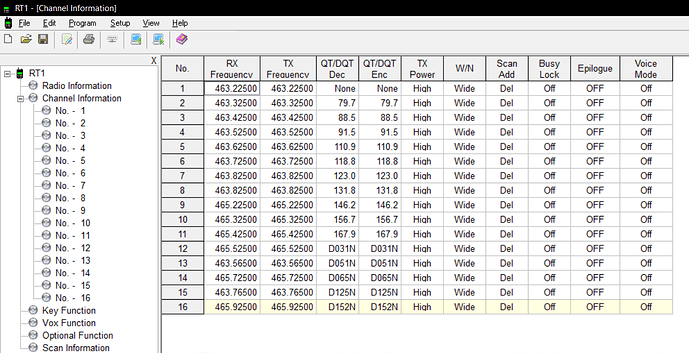
The manufacturer states this unit can be programmed up to the 520.00000MHz range.
The FCC’s guidelines for GMRS range is only within the 462 and 467 MHz frequency range
The manufacturer also claims to TX at 10W.
I’m going on a cruise and wanted to program my units to the best channel/frequencies possible that will take advantage of the 10w proclaimed by the manufacturer .
What is recommended.
Please assist.
To do what? Be aware that some cruise lines have a ban on radios so you will have to smuggle the radio on board, and one radio wont really give you any people to talk to as GMRS is American and cruise ships rarely stay in America, so on a ship, the use of radio is totally under the captain or masters control. The boat wont be American, even if it appears to be, it will be registered in some foreign country. Radio hams occasionally get granted permission to use a radio on board with lots of paperwork. Random passengers walking along with a radio will draw the security folk. Hiding them can be even worse. Expect it to be spotted during x-ray on most cruise lines. Most radios on board will be a mix of marine analogue VHF and digital, both UHF and VHF.
What are you hop8ng to do with it?
Thank you for chiming in. Wow, I did not know about the stringent restrictions and the floating locale/origin of the ship while at sea.
My cruise is up the East Coast to Canada with Norwegian.
I’ll need to contact the cruise-line to inquire about any radio restrictions.
My primary use will be to keep in contact with another family member while onboard.
Oddly - I hate cruising but When I was teaching, loads of my college students had great times working on board, but rules can be amazingly strict on any subject, let alone anything they may consider safety linked. Since then I’ve been on ships doing rigging and as visiting bands, and P&O, for instance would not allow us our walkie-talkies, because they did not have time or inclination to investigate and test them, so just handed us some of theirs - so it’s not really radios they don’t like, but what they could be used for. So many come with frequencies totally banned. Yesterday a new VHF radio arrived and when I downloaded the radio, it was programmed with marine band channels - I had not asked for this, but they were not the real marine frequencies, which use a mix of simplex and semi-duplex - just 25KHz channels starting at 156.000 (An emergency coastguard channel not available to the public here) and going upwards for 128 channels! Anyone buying these could cause serious problems and because they were set for simplex, they might be totally unaware as they’d not hear the coastal stations using them. This is why they hate random radios. The RT1 is a decent radio but just because it can be programmed for a set of channels, in some jurisdictions this is still risky, approvals wise. You also need to keep in mind the people you speak to at the cruise line won’t be technical, and are very unlikely to pass your request on.
For what it is worth, I’m aware that lots of the groups of workers (mine were the singers, dancers and technicians) use zello on their phones, using the ships internet. Data usage is minimal, and they set up big groups, so the friends can all hear each other. Using a phone also makes them inconspicuous, and as there are nodes everywhere, they work in cabins and anywhere. Radios are actually rubbish - radio to radio, as everywhere is metal compartments that are very range unfriendly.

Understand that Chinese manufacturers generally program these radios with random default frequencies and expect end users will program them properly. Using any of these frequencies mean you will possibly interfere with licenced users, and can possibly even interfere with critical public safety transmissions.
Personally, I would check with the cruise ship line for their policy on GMRS/FRS radios, and if allowed, I would program them to the FRS channels. Just be careful not to use them inside territorial waters because these radios are not certified in the U.S. or Canada for either GMRS or FRS channels. But outside territorial waters - which is where you will get the most use out of them - the rules don’t apply. But please delete those default frequencies and check with the cruise line.
Lots of passengers use FRS, GMRS and Motorola FHSS radios; but some cruise lines will only allow radios that are bought or rented on board. If they do allow personal radios, just reprogram them and avoid use in illegal territorial waters, and enjoy the radios.
You can never guess with cruise ships. Their rules are crazy. status is everything. On some lines, crew members must leave an elevator(lift) if a passenger gets in but on others it’s fine. Some have a very strict NO alcohol rule and have a cut price bar for the crew, others allow certain grades to talk to passengers, but they must remain standing. If you are one grade above, you can sit with a guest, but not drink. One grade above, you can drink with the passenger. You can see how radios could easily be a problem, but these restrictions don’t creep into the documents you’ve got.

- Remember me Not recommended on shared computers
Forgot your password?
- General Discussion
GMRS onboard Cruise Ship?
By Over2U August 6, 2022 in General Discussion
- Reply to this topic
- Start new topic
Recommended Posts
Oceania Cruises specifically prohibits “ham” radios. Has anyone experienced difficulty bringing along a GMRS Radio?
Link to comment
Share on other sites.

30 minutes ago, Over2U said: Oceania Cruises specifically prohibits “ham” radios. Has anyone experienced difficulty bringing along a GMRS Radio?
I would assume the way they see it, they are all the same and a no go.
Pretty much in ALL cases, use of personally owned transmitters is by permission of the captain/ship-owners, and under the laws of the country in which the ship is registered. GMRS is US (with a limited variant in Canada -- Canada's GMRS is closer to the US restructured FRS).
Quote § 95.307 Authorized station locations. Personal Radio Service stations generally may be operated in any location included within the descriptions in the following paragraphs in this section. In certain specific locations, however, co-ordination procedures or operating restrictions may apply, as set forth in § 95.309 . Operation of Personal Radio Service stations in any location outside of those described in the following paragraphs is not authorized by this part. ( a ) Within the United States and its territories. Those areas include the fifty United States and the District of Columbia, the Commonwealth of Puerto Rico, Navassa Island, the United States Virgin Islands (50 islets and cays), American Samoa (seven islands), Baker Island, the Commonwealth of Northern Marianna Islands, Guam Island and Howland Island, Jarvis Island, Johnston Island (Islets East, Johnston, North and Sand), Kingman Reef, Midway Island (Islets Eastern and Sand), Palmyra Island (more than 50 islets), and Wake Island (Islets Peale, Wake and Wilkes). ( b ) Aboard any vessel or aircraft registered in the United States. With the permission of the captain, while the vessel or aircraft is within or over the United States or its territories, U.S. territorial waters, or upon or over international waters. ( c ) Aboard any unregistered vessel or aircraft owned or operated by a United States citizen or company. While that vessel or aircraft is within or over the United States or its territories, U.S. territorial waters or upon or over international waters. ( d ) Other locations. Any other area of the world, except within the territorial limits of areas where radio services are regulated by: ( 1 ) An agency of the United States other than the FCC. (You are subject to its rules.) ( 2 ) Any foreign government. (You are subject to its rules.)
Quote With headquarters in Miami, Oceania Cruises is owned by Norwegian Cruise Line Holdings Ltd., a diversified cruise operator of leading global cruise brands which include Norwegian Cruise Line, Oceania Cruises and Regent Seven Seas Cruises.
Good chance that the ships are also registered to Norway, and hence under Norway's rules regarding radio transmitters. And I'm certain they do not authorize a GMRS service.
Quote PMR446 UK / European Walkie-Talkies "PMR446" is a UK & European Union standard for radios approved for use in the UK and the European Union. They have 8 channels at frequency 446MHz, and a maximum range of around 2 miles in open country. No PMR446 radio can have more than ½ watt of transmission power, so all makes and models of PMR446 walkie-talkie will effectively have the same maximum range.
Essential pre-restructured FRS capability, but different frequency band. In fact, they are in the middle of the US Amateur 70cm band (430-450, though repeaters are mostly in 440-450).
Quote FRS / GMRS American Walkie Talkies FRS and GMRS are American official standards for consumer radios widely sold in shops in those countries. They have 14 - 22 channels, on frequencies at 462 and 467MHz. They will not communicate with European PMR446 radios and are NOT LEGAL to use in the UK or Europe. In the USA and Canada the electrical mains voltage is 120 volts, rather than the 240 volts used in Europe and the United Kingdom, so there could be problems with UK voltage blowing up the US 120v chargers. There is NO SUCH THING as a "combined" European / American walkie-talkie that is legal to use in both places, since such a radio would, by definition, be capable of transmitting on non-legal frequencies as well, and would therefore not be legal in either country.

I literally just got off a cruise (Royal Caribbean). The boarding security took out my GMRS HT's, turned them on and off to make sure they weren't bombs, and handed them back to me.
I'm sure you'll be fine! FYI, Greece, Italy, and Montenegro apparently couldn't care less, either...

International waters and Flags of Convenience... cruise ship gambling! alcohol during Prohibition! no controlling legal authority! https://wikiless.org/wiki/Flag_of_convenience?lang=en
Took some searching, but apparently (at least) two of the line's ships is operating under the flag of the Marshal Islands.
I hadn’t thought about the rules of the country of ship’s registry. As I will be embarking and disembarking on U.S. soil I may bring my radio, on the assumption that, if confiscated, it will be returned. Thanks to everyone for so much research on my behalf!
- 2 weeks later...
We have seen and talked to people that have brought FRS radios and they have all worked with a very limited range. Ships are big hunks of steel with lots of obstacles in them. The only thing that MIGHT make them more usable is that GMRS channels have more power. Even with that, I would not hold my breath.

I spend a lot of my time on ships due to my work. Once when I took my wife, we took Midland GTX100 radios. They worked very well. At one point I was on deck 9 aft, lying int he sun, and my wife went to deck 1 midship to guest services. I was able to talk to her while she was there. Yes, there is a lot of steel, but you would be surprised. Just don't expect them to work everywhere. They are useful on deck. In port, remember that you are not in the US, and the laws governing the island may not allow the use of the radios.
- Over2U and WRTY790

Join the conversation
You can post now and register later. If you have an account, sign in now to post with your account. Note: Your post will require moderator approval before it will be visible.

× Pasted as rich text. Paste as plain text instead
Only 75 emoji are allowed.
× Your link has been automatically embedded. Display as a link instead
× Your previous content has been restored. Clear editor
× You cannot paste images directly. Upload or insert images from URL.
- Insert image from URL
- Submit Reply
- Existing user? Sign In
- Online Users
- Leaderboard
- All Activity
- Classifieds
- Create New...
Important Information
By using this site, you agree to our Terms of Use and Guidelines .

Pride of America cruise ship gets rare opportunity to dry-dock at Pearl Harbor

Over the weekend, a Hawaiʻi-based cruise ship paid a rare visit to the Pearl Harbor dry dock for a regulatory inspection. It doesn't happen very often, but it can be done.
Navy ships normally take priority at the Pearl Harbor Naval Shipyard, but it just so happened a window was available — enough time for the Norwegian Cruise Line ship Pride of America to get a routine inspection, rather than traveling thousands of miles to the U.S. West Coast.
The Conversation talked to Pacific Shipyards International CEO Iain Wood and Vice President of Programs Troy Keipper about dry-docking the commercial vessel. The company was founded in Hawaiʻi in the 1940s.
Thanks to a public-private partnership, workers were able to get the cruise ship in on Friday and out on Sunday.
This interview aired on The Conversation on May 3, 2024. The Conversation airs weekdays at 11 a.m. on HPR-1.


IMAGES
COMMENTS
cruise ships - cruise line frequencies maritime scanning radios vhf uhf mhz 457.5250 457.5500 457.5750
99.9999% of ships use the same frequencies. 457.5000 - 457.8250. 467.5000 - 467.8250. Whether they use the 457 or 467 as the output, varies by who did the programming. jlp said: I'm planning a trip on the Norwegian Cruise Liner Escape. Bringing the SDS100 for shipboard VHF/UHF comms. The Tecsun with AM loop for SWL/BCB.
24. Compressed gas tanks, bottles, cylinders including dive tanks, propane tanks and large aerosol cans. 25. Emergency Position Indicating Radio Beacons (EPIRB), ham radios, satellite phones, transformers, lasers and laser pointers. 26. Any form of radio/ telephone signal jamming equipment.
Norwegian Cruise Line recently added walkie-talkies to their list of prohibited items to bring on a cruise with you. ... Radio frequencies in the USA are managed by the Federal Communications Commission (FCC). Different frequencies are managed into specific named ranges for different services. For instance, we have a range of frequencies set ...
457.525 [85.4] Norwegian Epic 469.0 [186.2] Norwegian Epic - Shore Excursions ... Saint Kitts Scanner Frequencies and Radio Frequency Reference (plus unidentified frequencies in the wiki: Saint Kitts (KN) - The RadioReference Wiki) ... Nothing in my notes for 462.6500 as a Cruise Ship Freq, however the input 467.6500 is commonly used
Any given radio in this category will have the same range, provided you're comparing two models with the same output (again, some models output 2 watts on specific frequencies). On a ship, range will be greatly diminished. The range of any radio is dependent on several primary factors: Antenna design; Antenna height; Power output; Obstructions
Aug 4, 2023. #3. squadradio said: Going on a cruise soon and will be traveling on NCL and the ship Encore. I've searched through the forums here and done a deep Google search and was unable to locate any info/finds for NCL and Encore. As a long shot I thought I'd post a query here to see if anyone might have information on frequencies and ...
While tracking the inference we discovered there are many Cruise Ships and other Maritime vessels that use radios on a day to day basis that may or may not cause interference to existing [Commercial, Amateur, Media, GMRS etc] systems in the port areas. This web site is a collection of radio data that has been found thru Web Research, E-Mail ...
457.6000 94.8 Hz 467.8250 94.8 Hz 2013.05.09. mcscanner said: Jay, I just returned from a cruise on the NCL Jewel 3 weeks ago. For the few crew that had a device on their belt they looked like Motorola SL7550 series radios. Never got a good 'hold it in my hand look', but that was my impression of what I saw.
Scanner frequencies for cruise ships and ports around the world. Cruise Ships and Ports Scanner Frequencies. Also see these great resources: Cruise Ship & Maritime Frequencies; Cruise Ship Frequencies - radioreference.com Forums ...
Eric's Cruise Ship Frequencies. Cruise Ships and Ports - Scanner Frequencies Scanner frequencies for cruise ships and ports around the world. ... TRX-1: Inverted DCS on a non-image frequency--one radio disagrees with all the others. n4jri; Apr 5, 2024; Whistler Scanners; Replies 4 Views 490. Apr 5, 2024. n4jri. N. NCL Epic. Computrguy;
467.7500, 467.7750, 467.8000, 467.8250. Along with FRS/GMRS as some of the FRS Channels seem to be in-use. by the Cruise ships [outside of the normal FRS users too] Carnival seems to use the following Channel Plan, which might help as well. 457.5250 R Ch.01.
Just 18 months ago in January 2021, for example, Norwegian Cruise Line's prohibited items list only contained 28 items, whereas the addition of walkie-talkies brings the list to 32. At this time ...
UHF Radios - Ultra-High Frequency radios are powerful 2 ways radios that can transmit signals which can penetrate the steel structures of a cruise ship. Best Walkie-Talkie for Cruise Ship. The best walkie-talkie for a cruise ship is one that uses UHF frequencies, has multiple channels, and has a privacy code feature.
NCL (Norwegian Cruise Line) specifically prohibits walkie-talkies as of July 2023. Walkie-talkies should not interfere with the cruise ship's signals, such as distress calls. GMRS (General Mobile Radio Service) walkie-talkies, which provide more power and range, can be brought onboard if the user has a necessary license.
Cruise Line Scanner Frequencies : Carnival, Royal Caribbean, Princess & More... Scanner Frequencies. USA. Articles Contact Submit. ... 156.4500----NORWEGIAN CARIBBEAN CRUISE LINES 156.9750----NORWEGIAN CARIBBEAN CRUISE LINES 457.5250----NORWEGIAN CARIBBEAN CRUISE LINES
Here are the results from some ship areas where I conducted hands-on tests with walkie-talkie. 1- Using A Walkie Talkie Inside The Cabin. Using a walkie-talkie inside the cabin is only effective when the other person you want to communicate with is outside the hallway; then, the communication can be clear.. Communicating inside the cabin or balcony with a person on the above deck can create a ...
This is the default channel/frequency range: The manufacturer states this unit can be programmed up to the 520.00000MHz range. The FCC's guidelines for GMRS range is only within the 462 and 467 MHz frequency range. The manufacturer also claims to TX at 10W. I'm going on a cruise and wanted to program my units to the best channel/frequencies ...
Walkie-talkies are popular because good ones will work across the entire ship and let you talk to others in your travel group without spending hundreds on Wi-Fi packages. Here are the best walkie-talkies to purchase for your next family cruise: 🚢 Topsung M880 FRS Walkie-Talkies. 🚢 Retevis RT22 Walkie-Talkies. 🚢 MOICO Walkie-Talkies.
FRS / GMRS American Walkie Talkies. FRS and GMRS are American official standards for consumer radios widely sold in shops in those countries. They have 14 - 22 channels, on frequencies at 462 and 467MHz. They will not communicate with European PMR446 radios and are NOT LEGAL to use in the UK or Europe.
The Norwegian Cruise Line ship Pride of America at Dry Dock 4, Pearl Harbor, April 26, 2024. The ship arrived Friday afternoon, was inspected on Saturday, and departed the dry dock early Sunday morning.